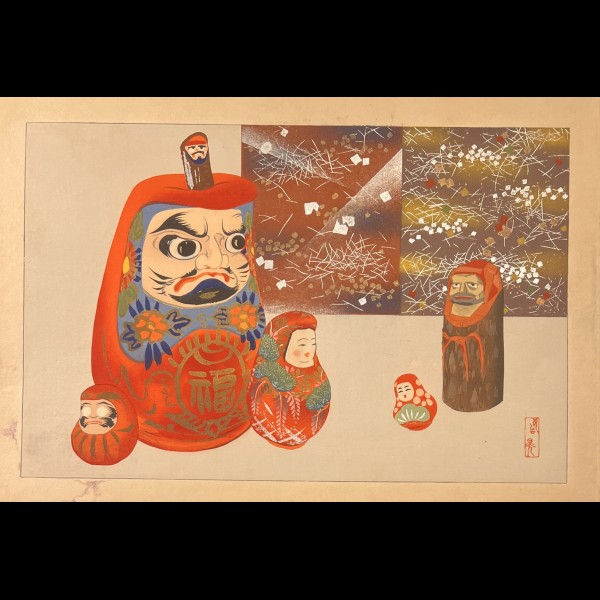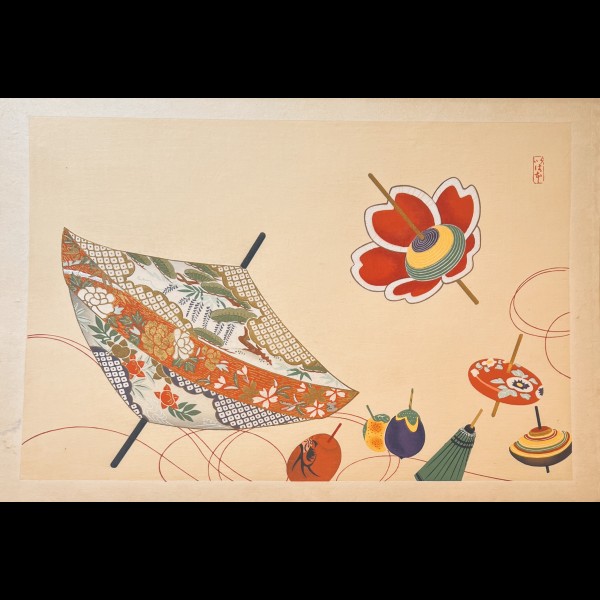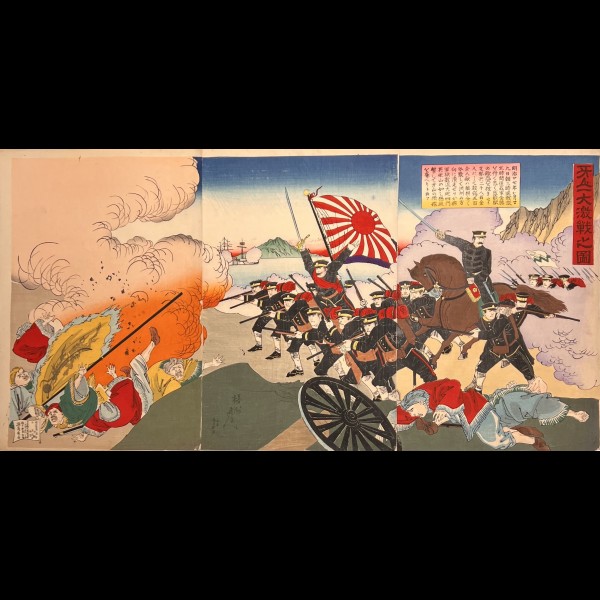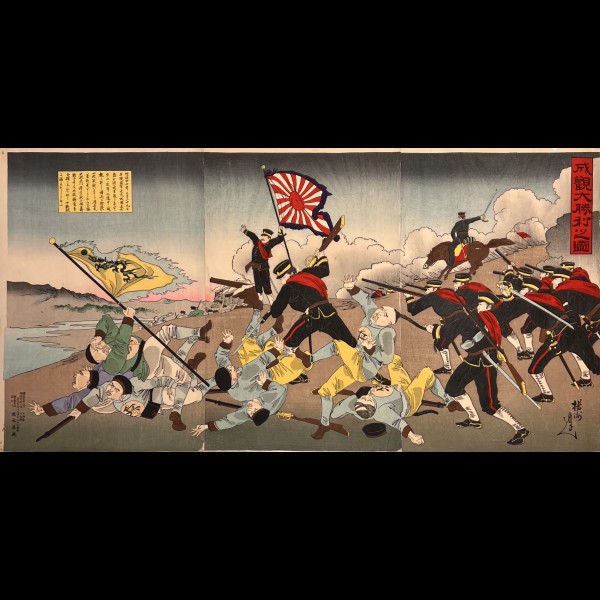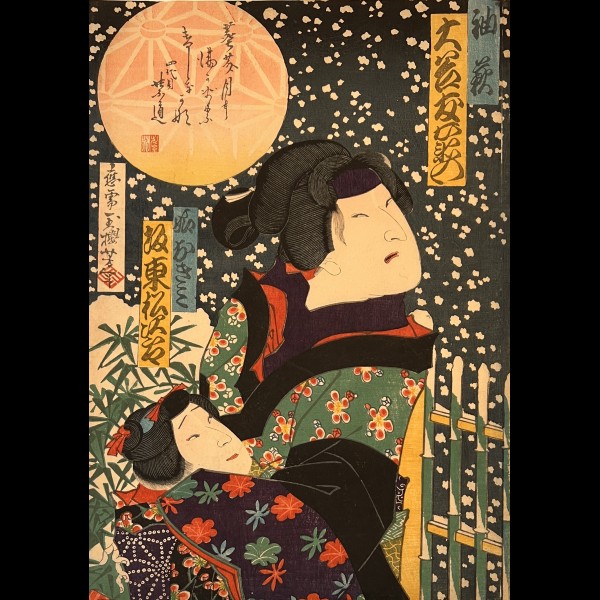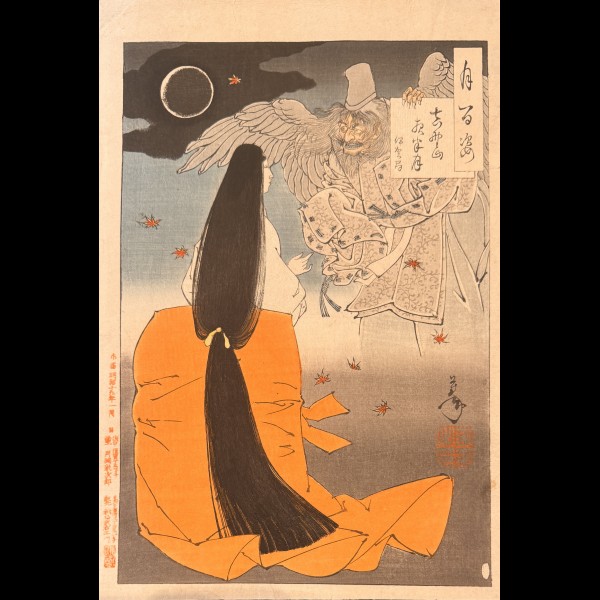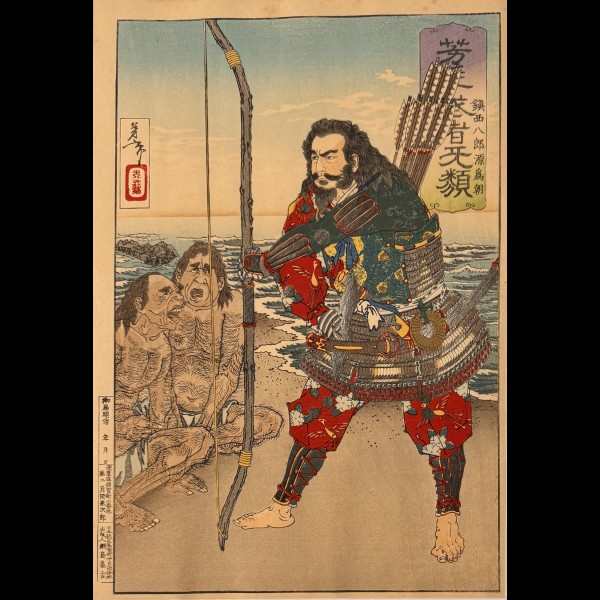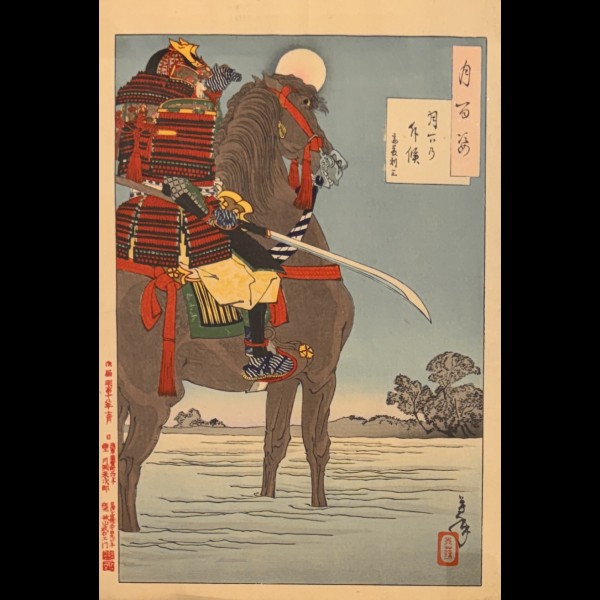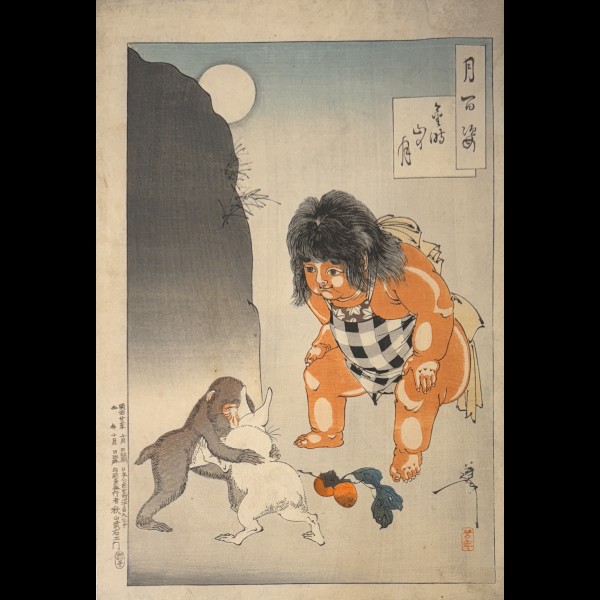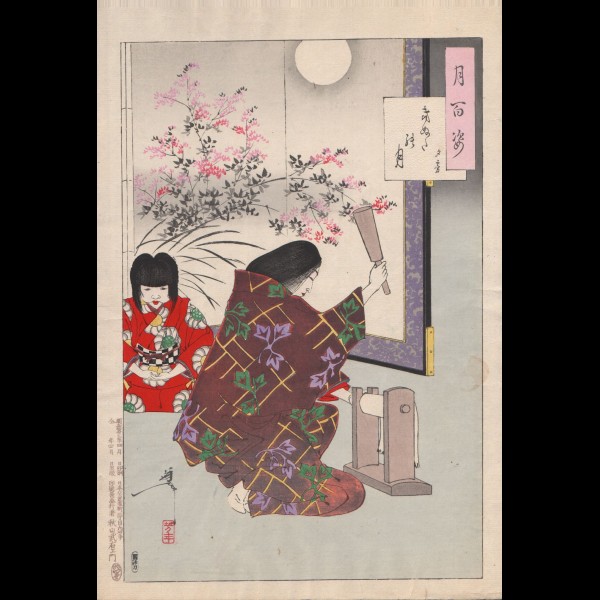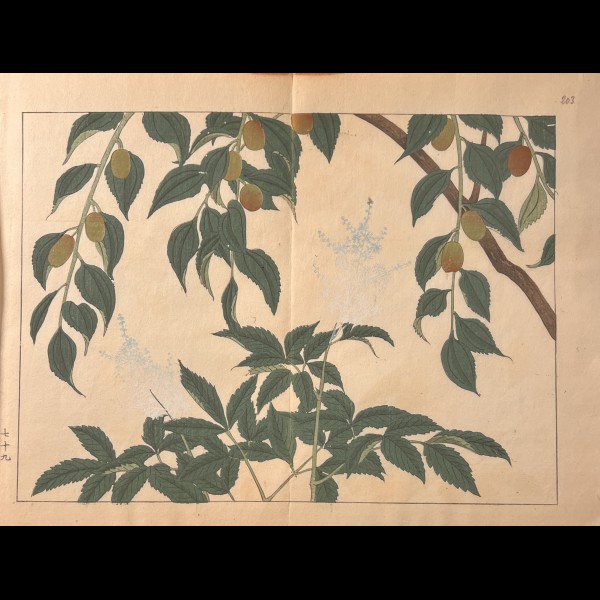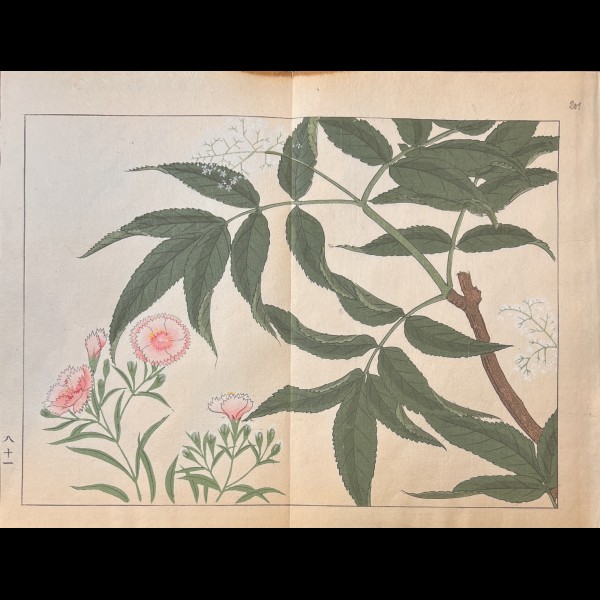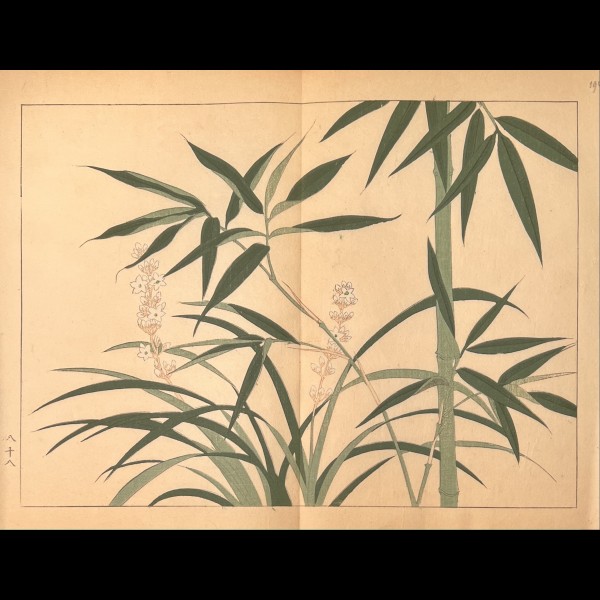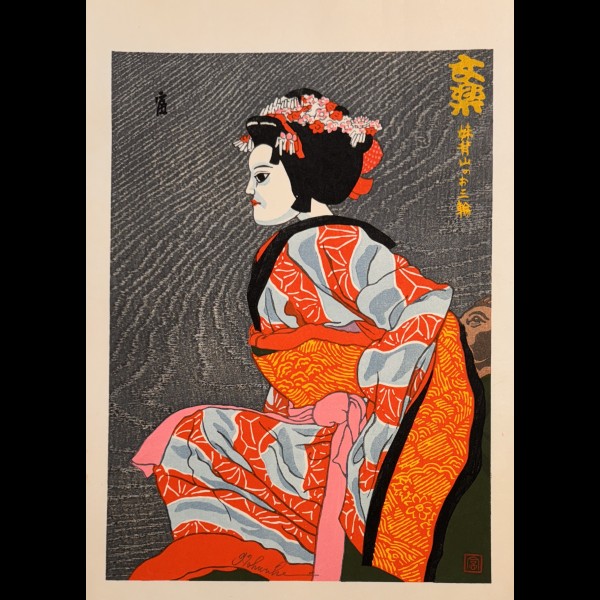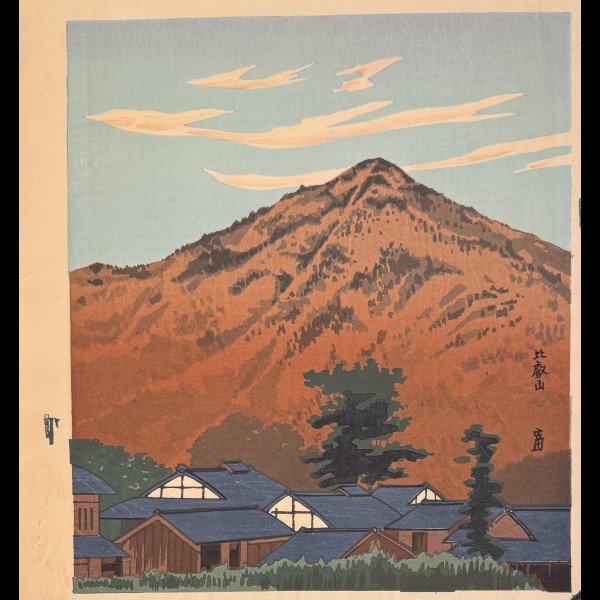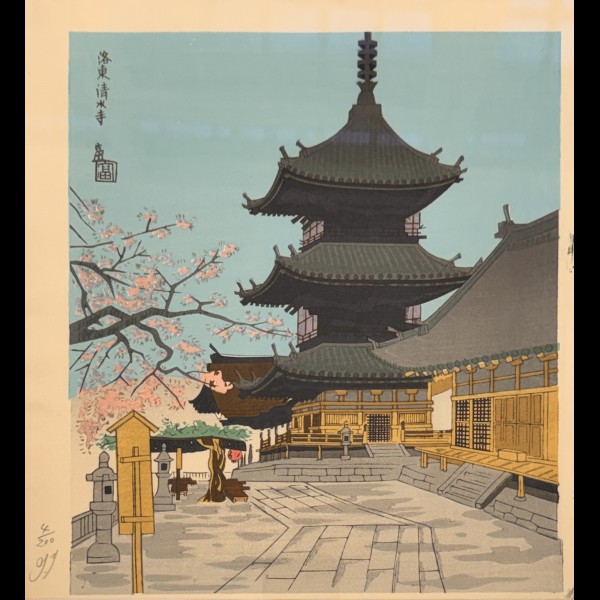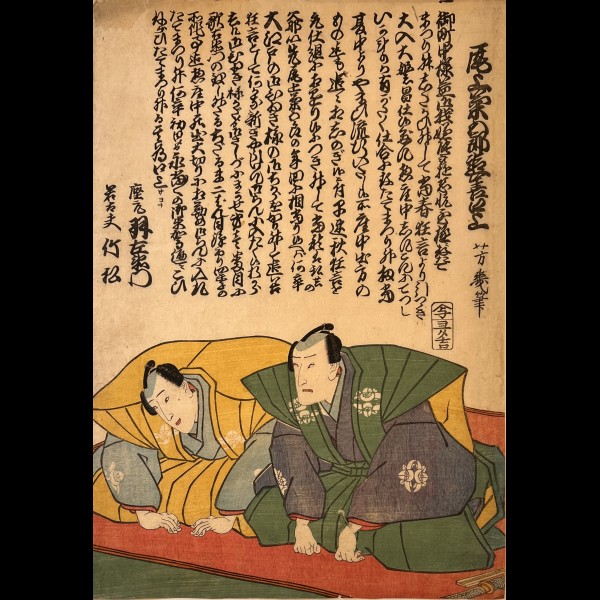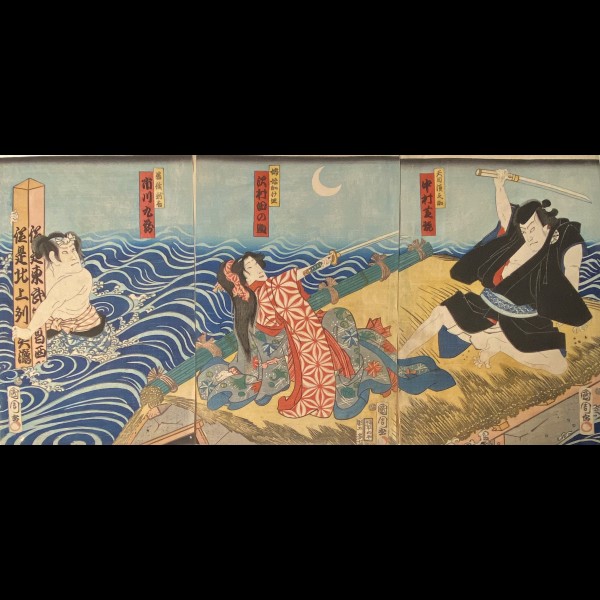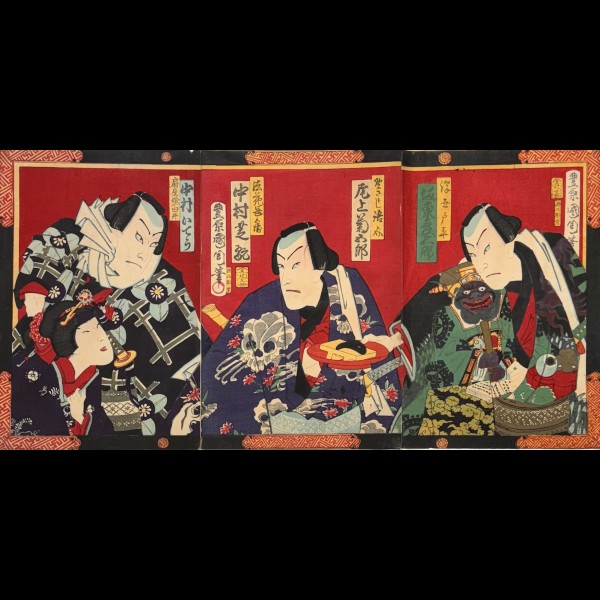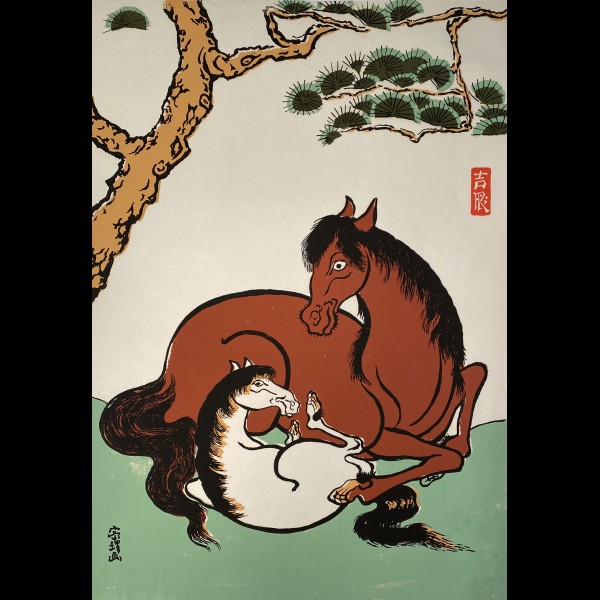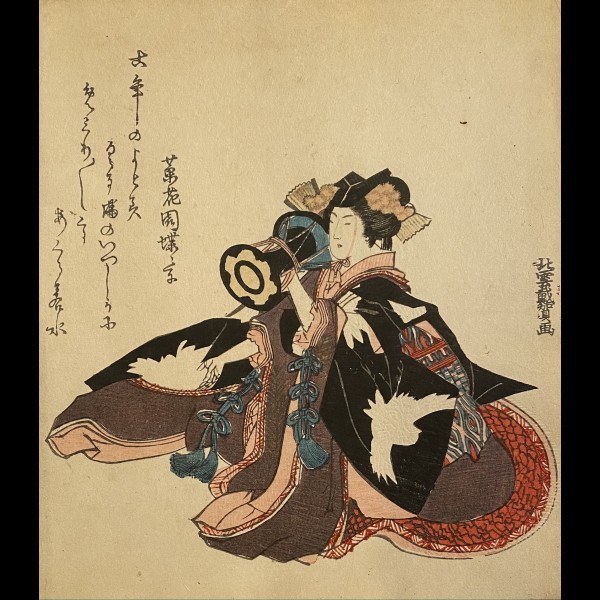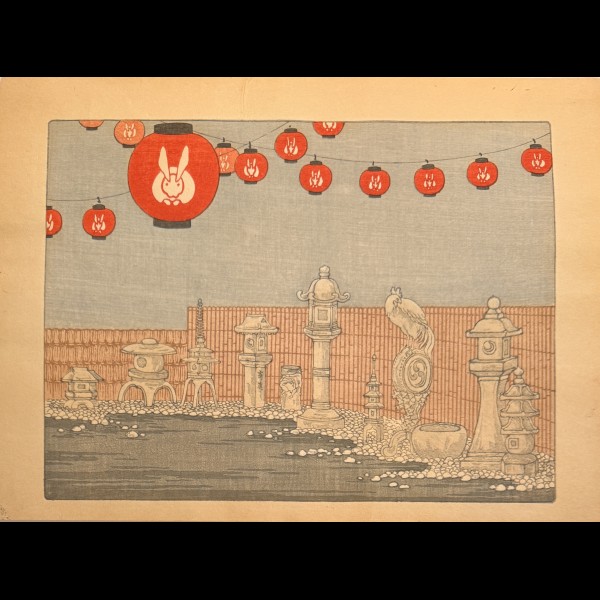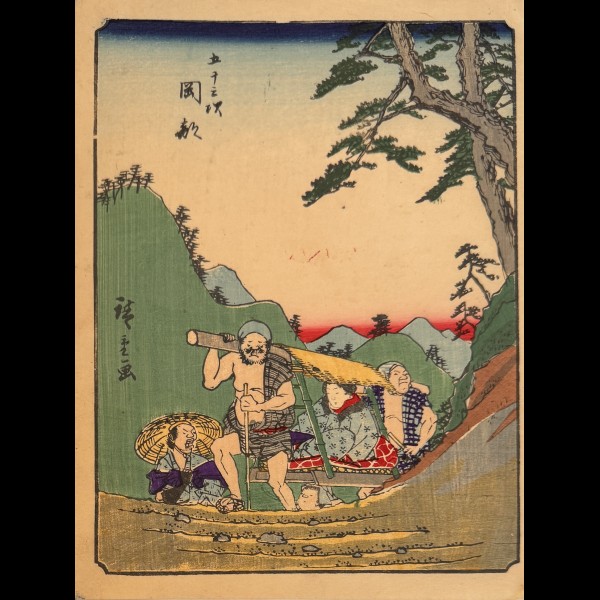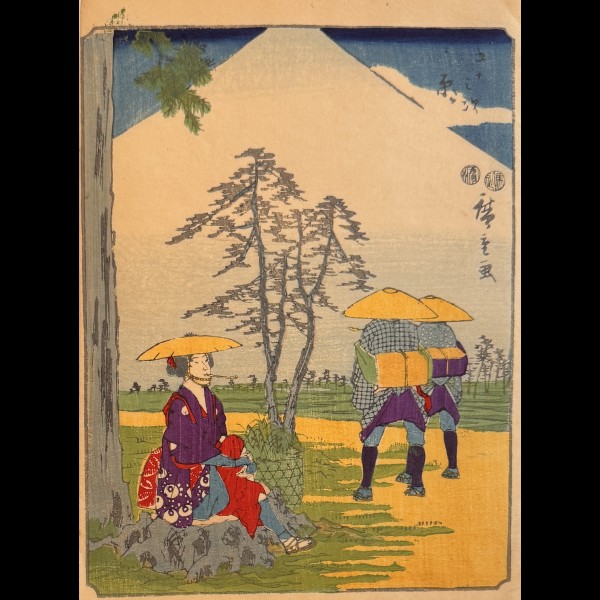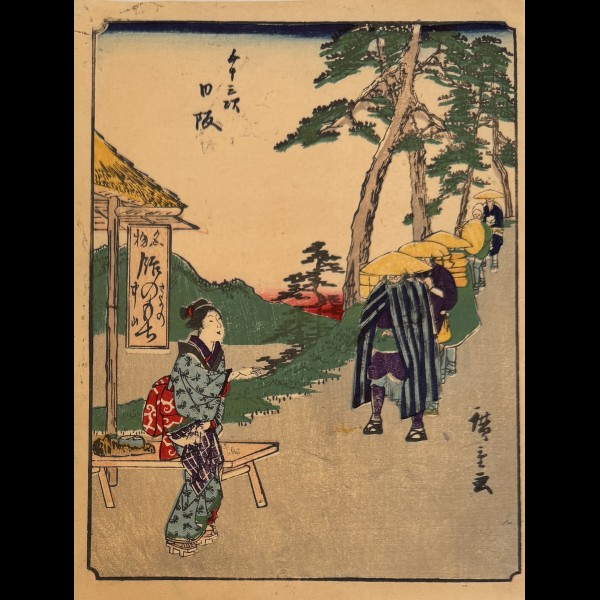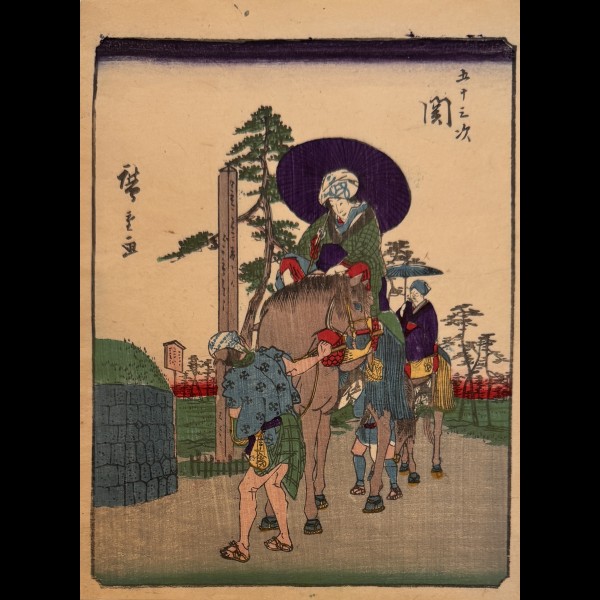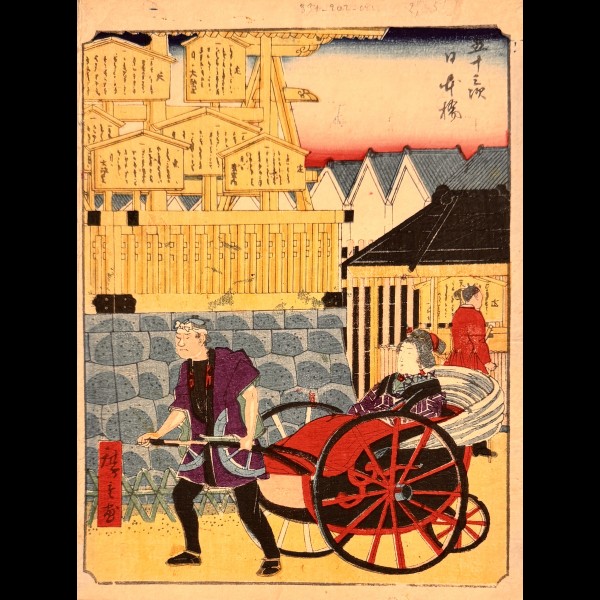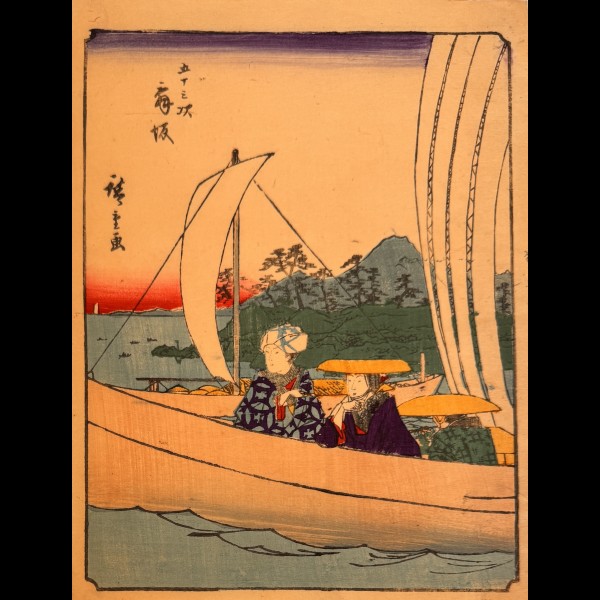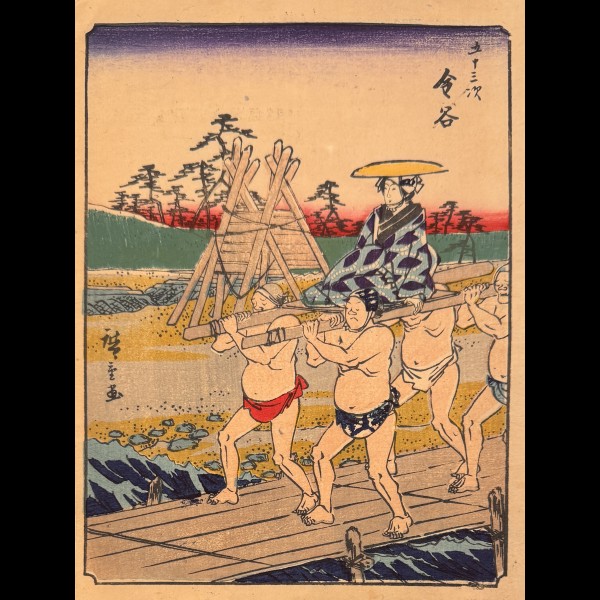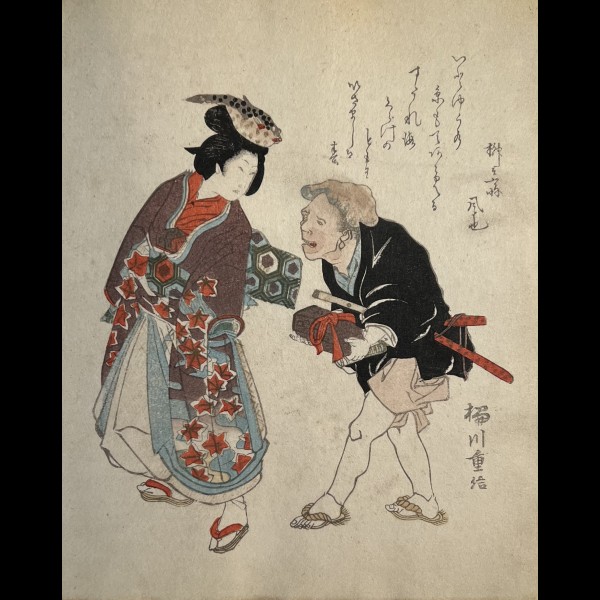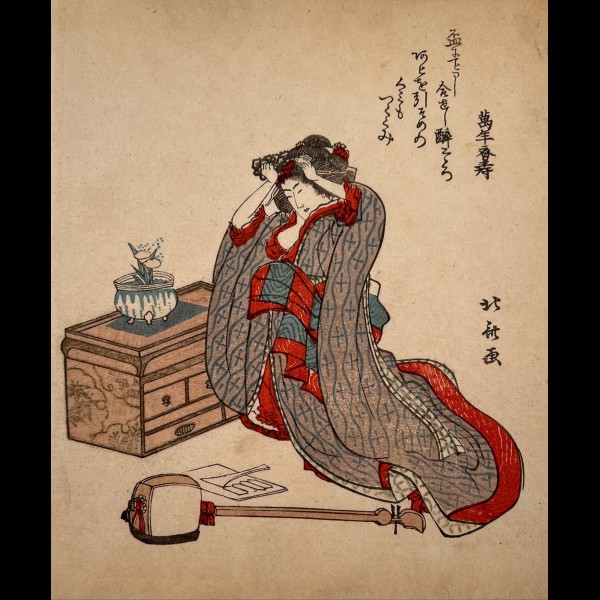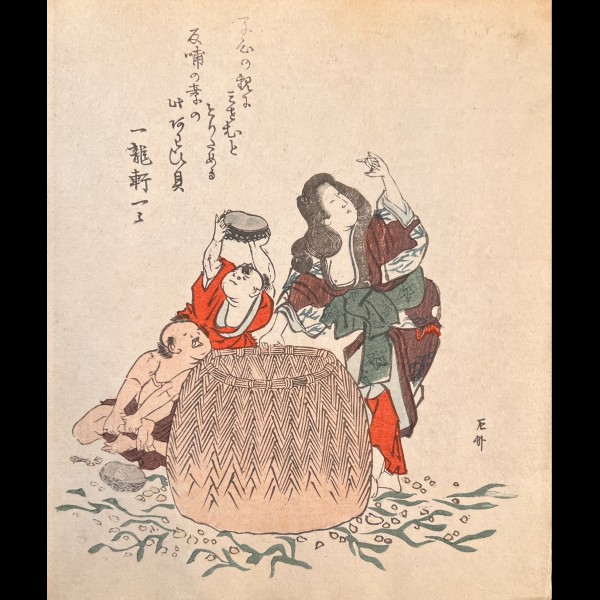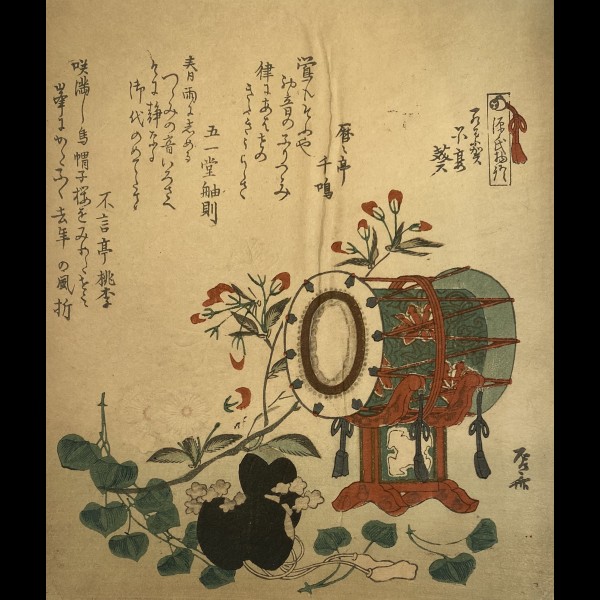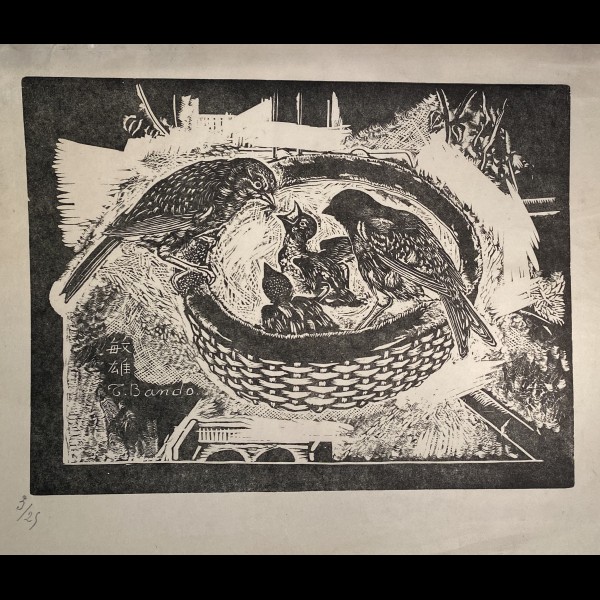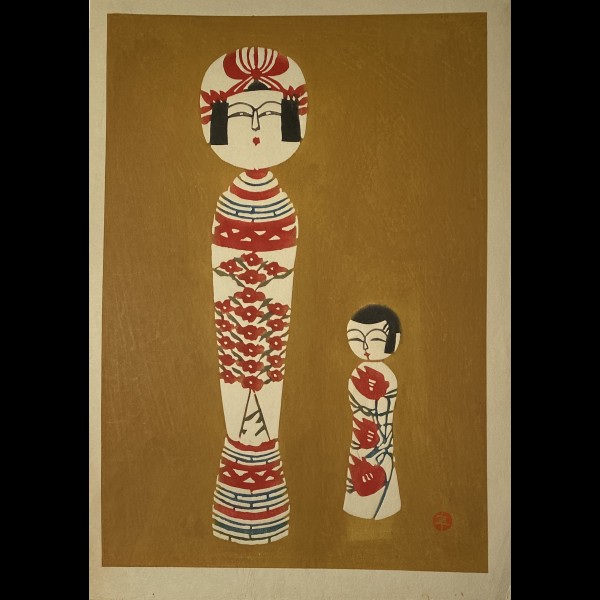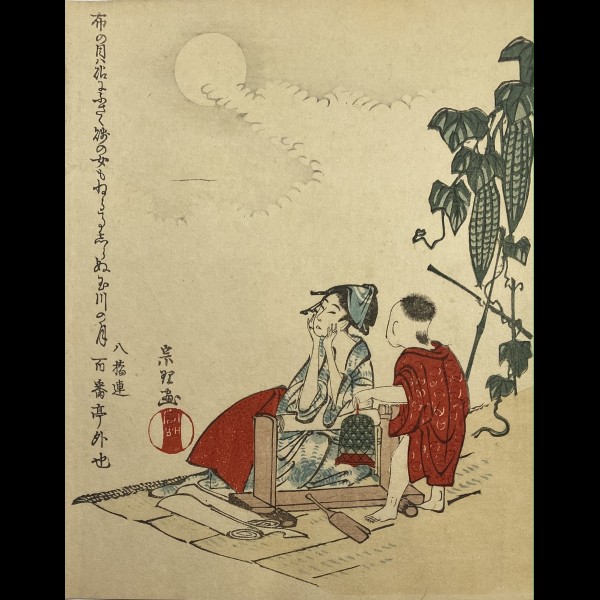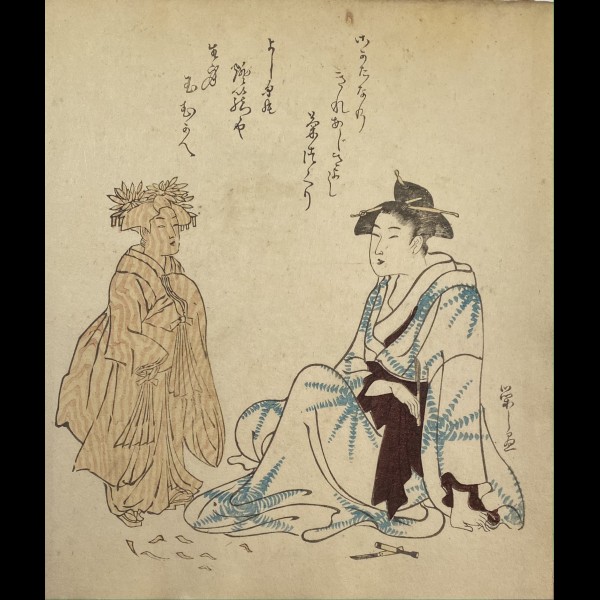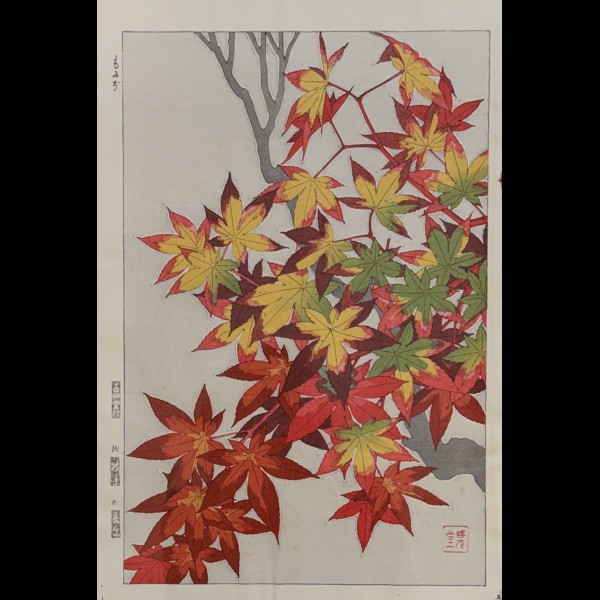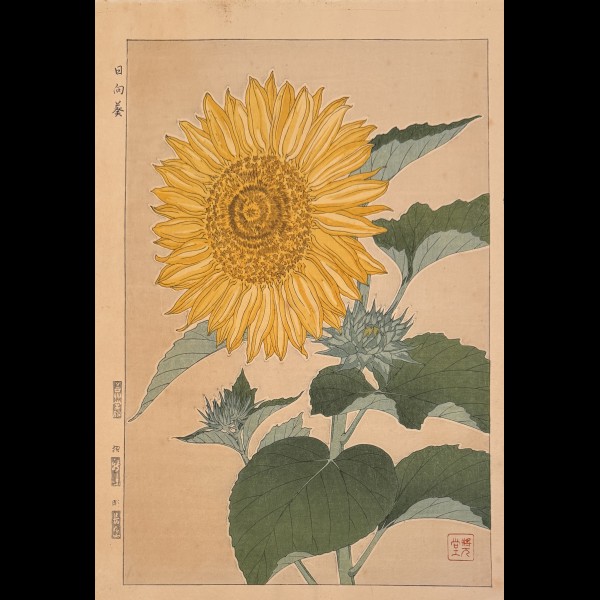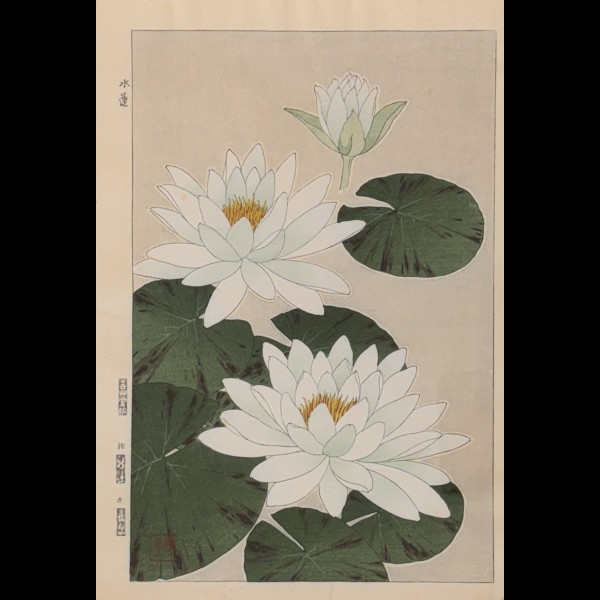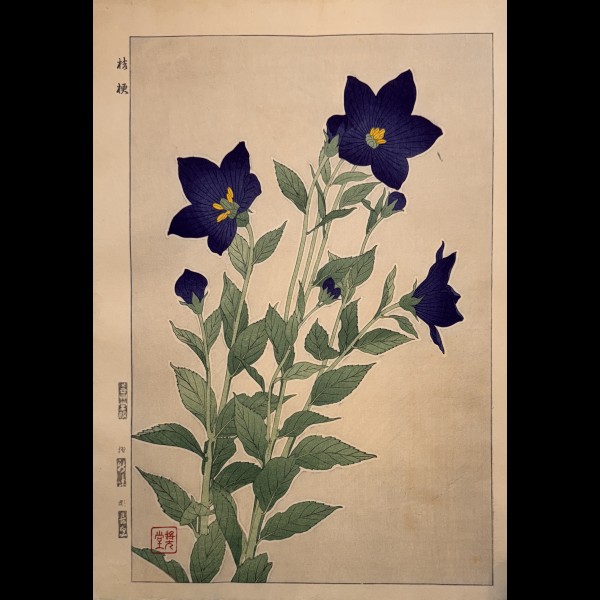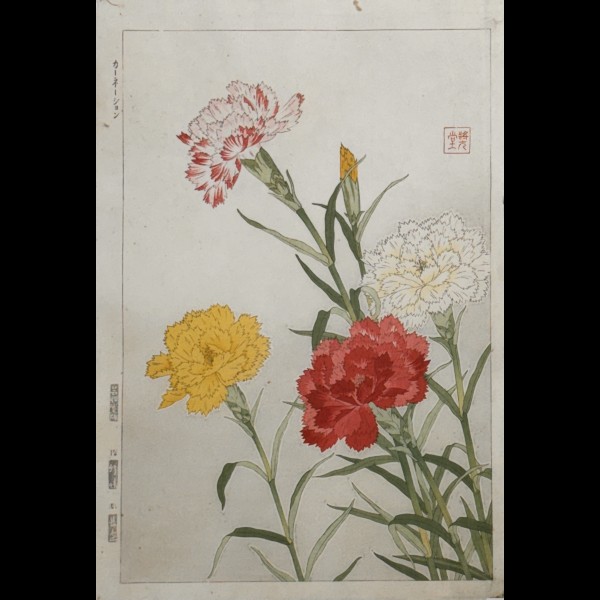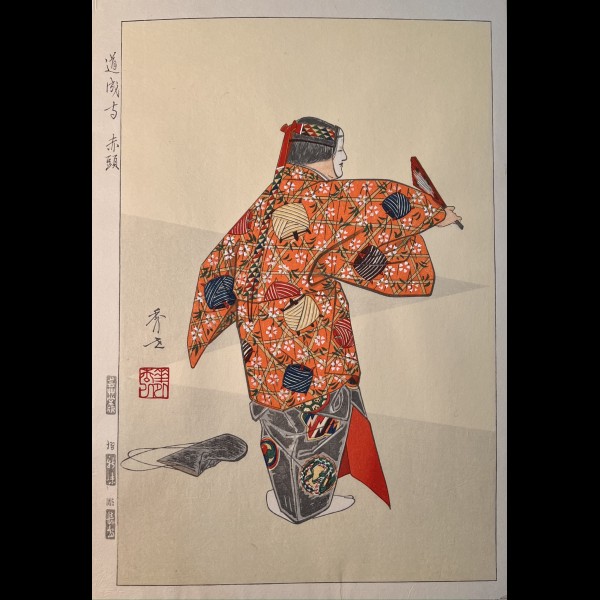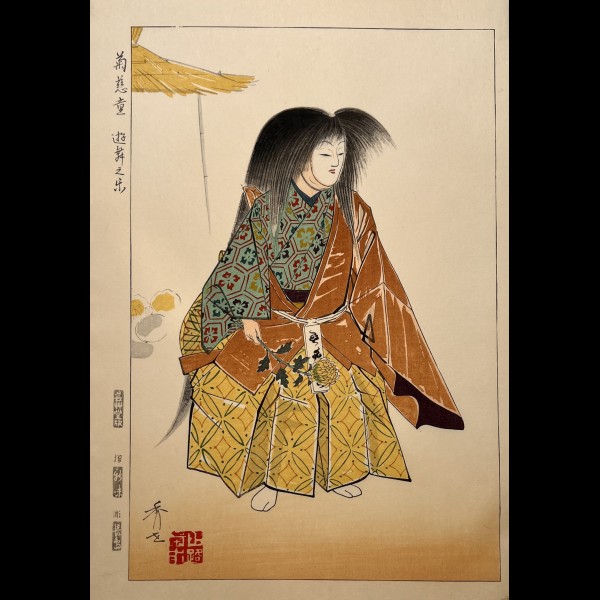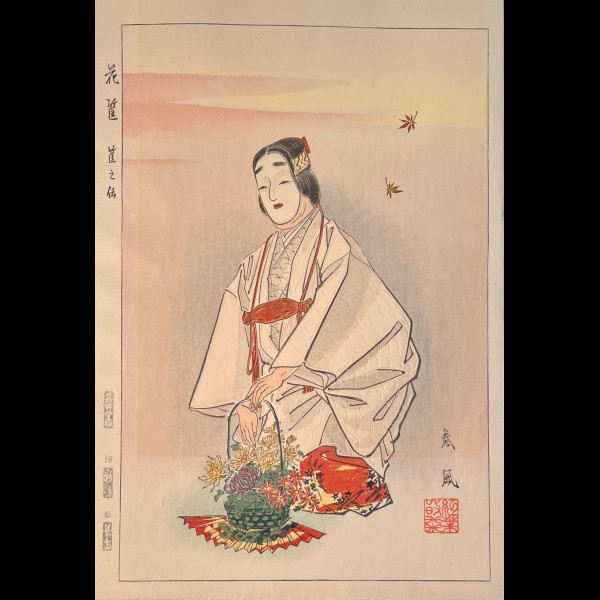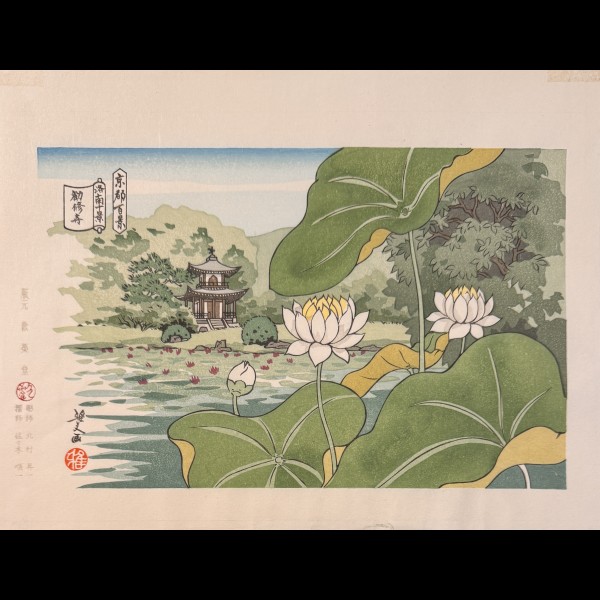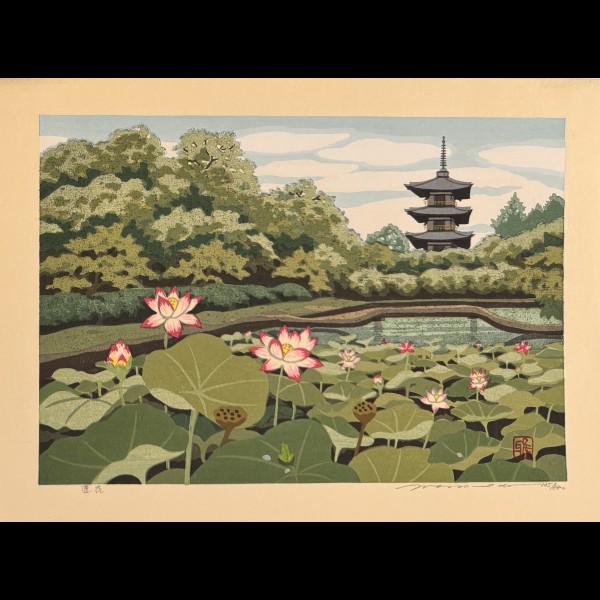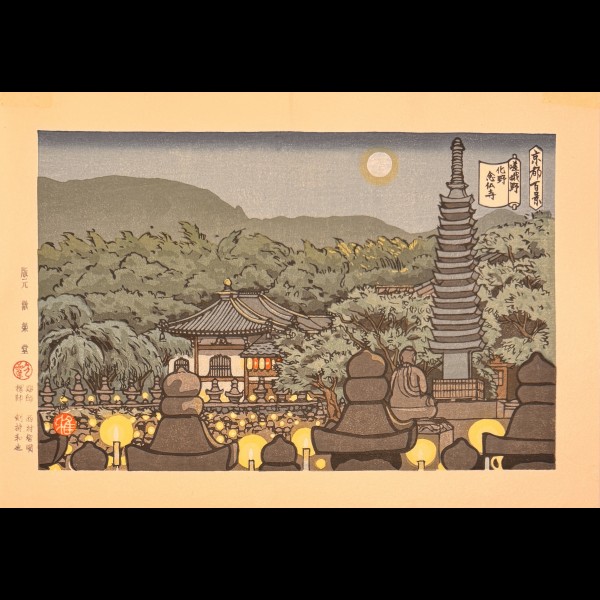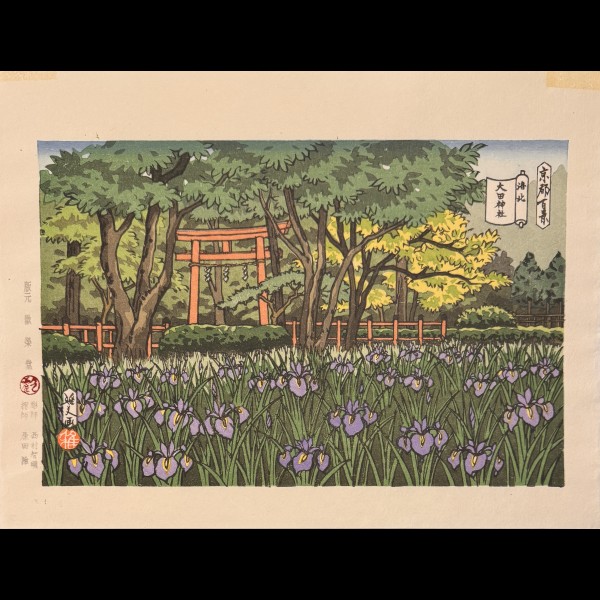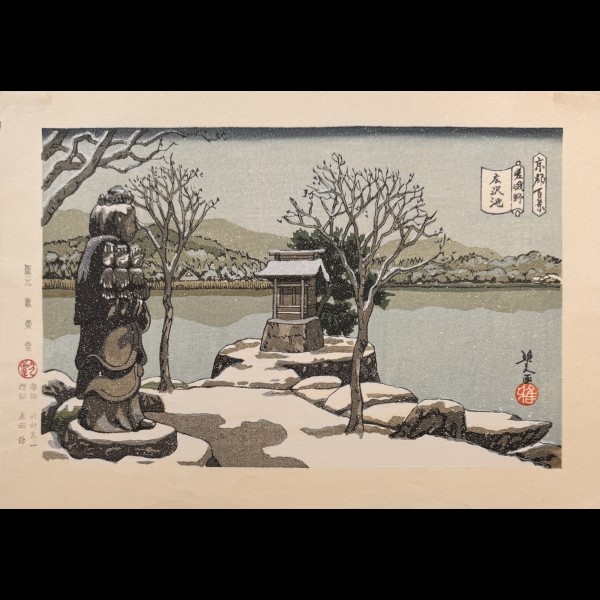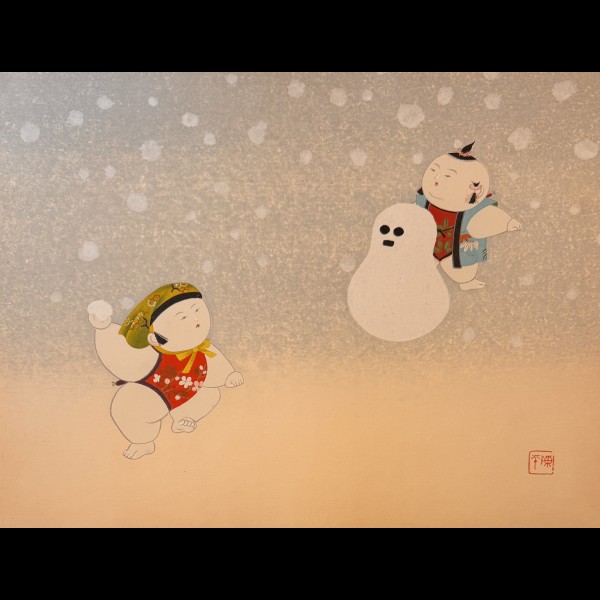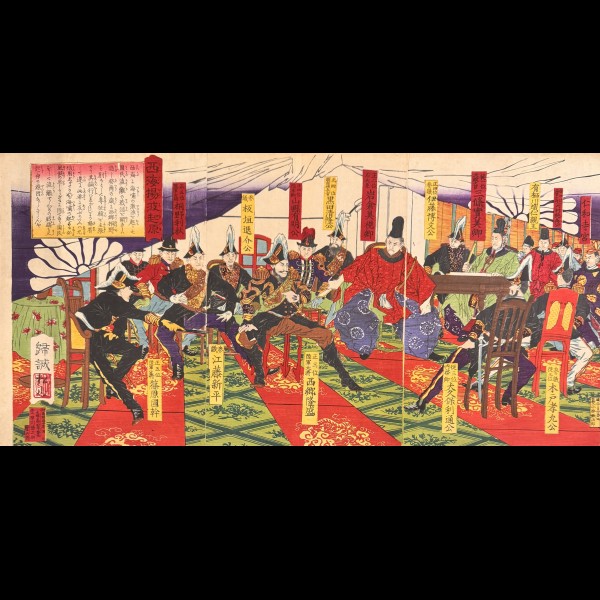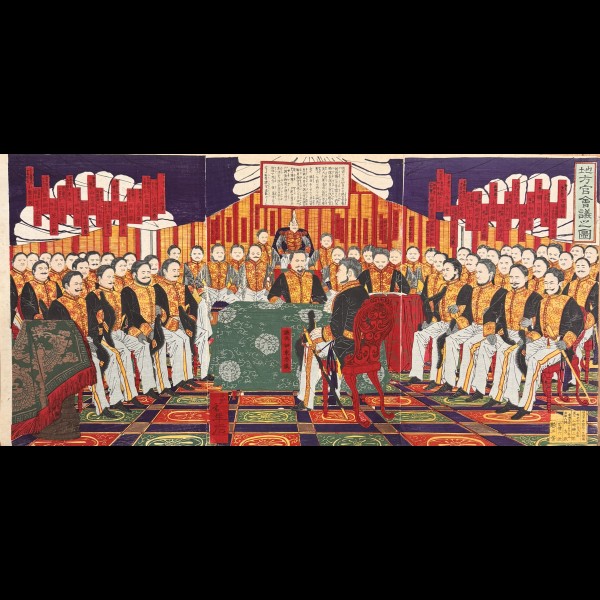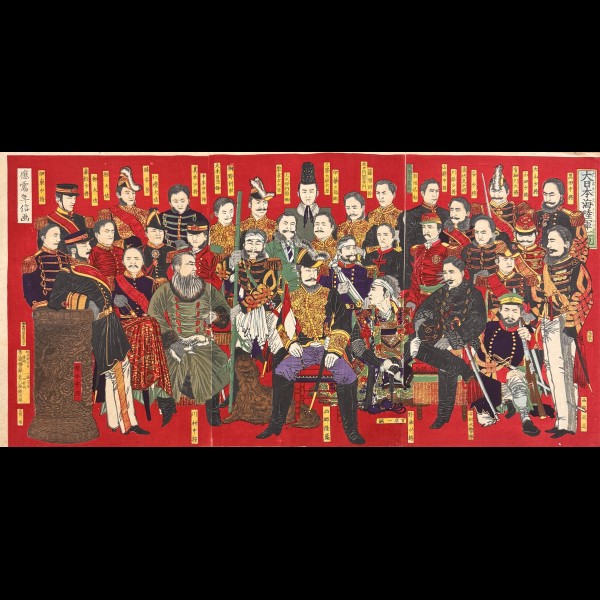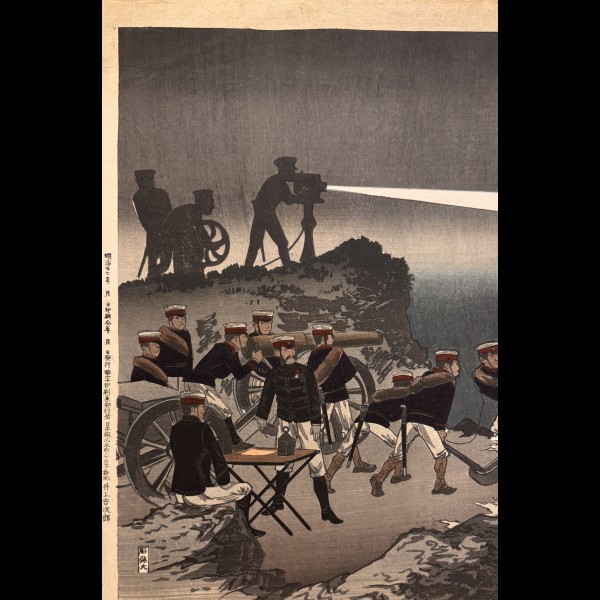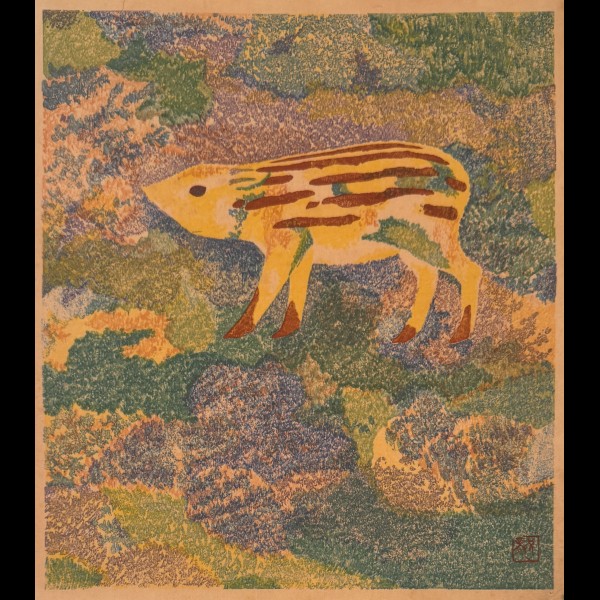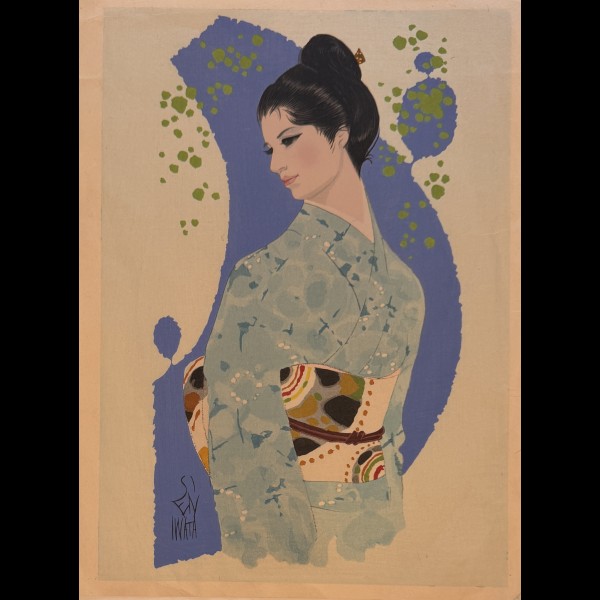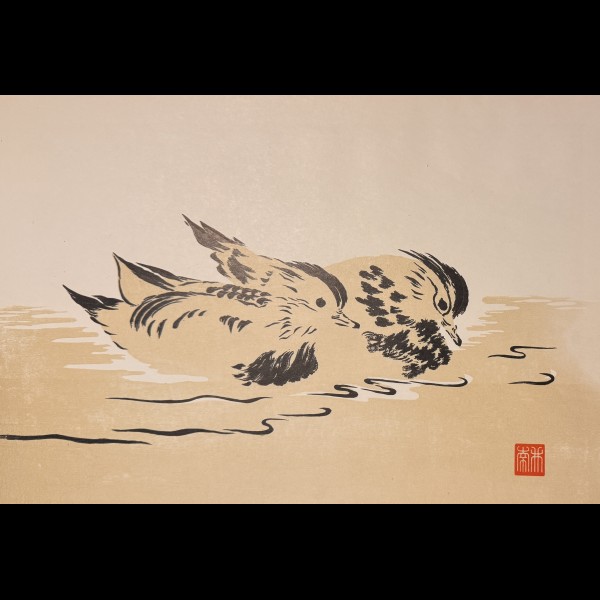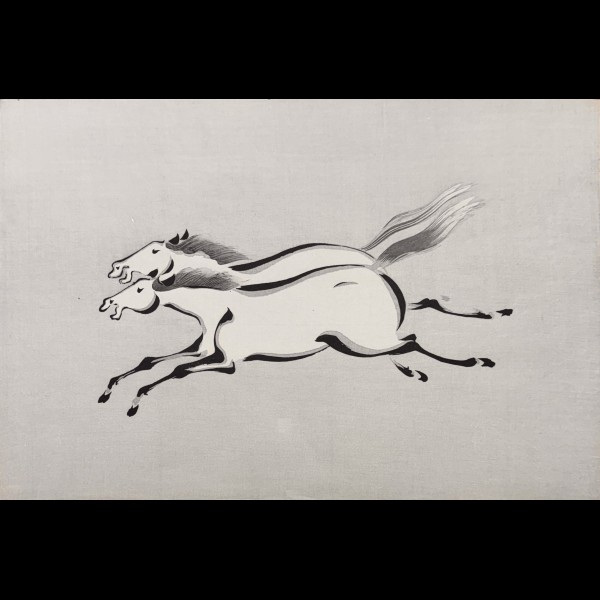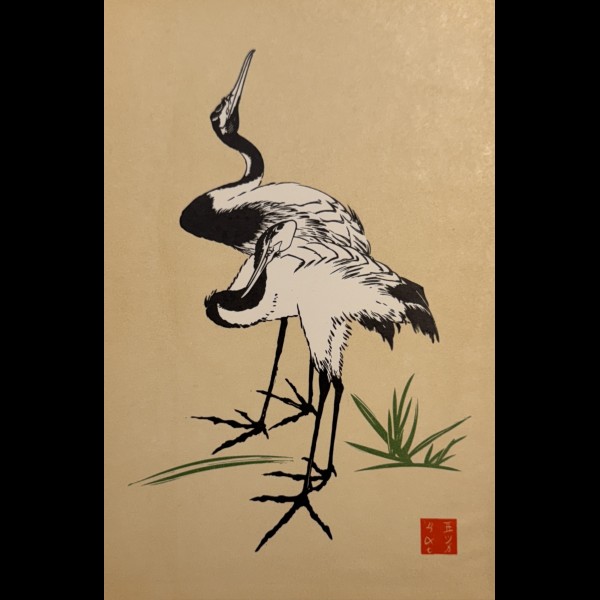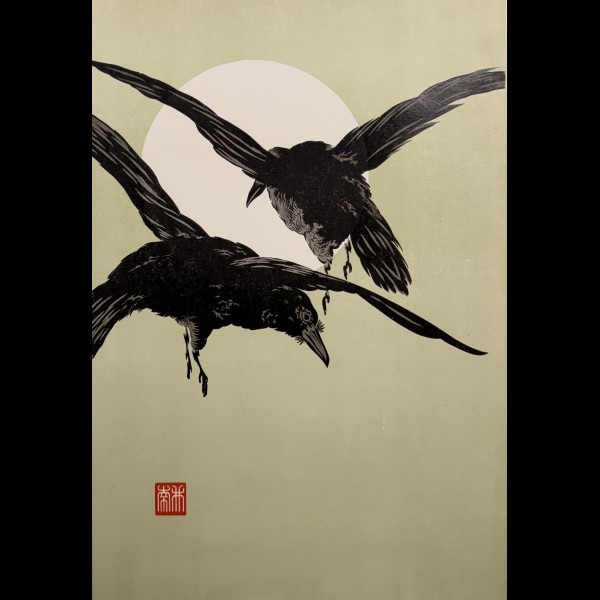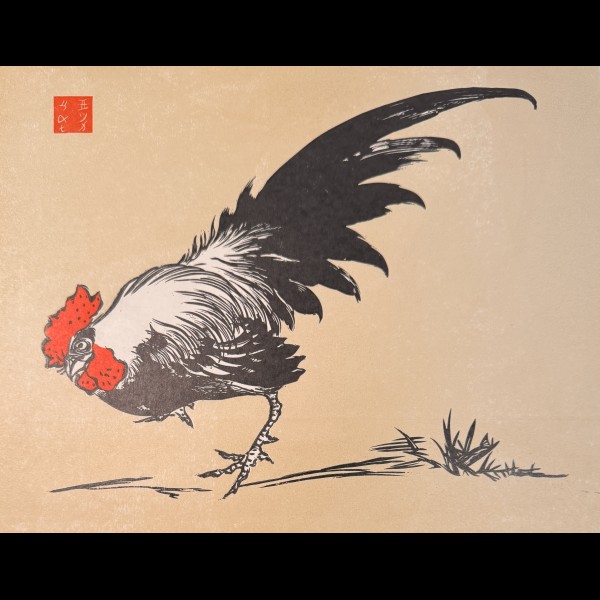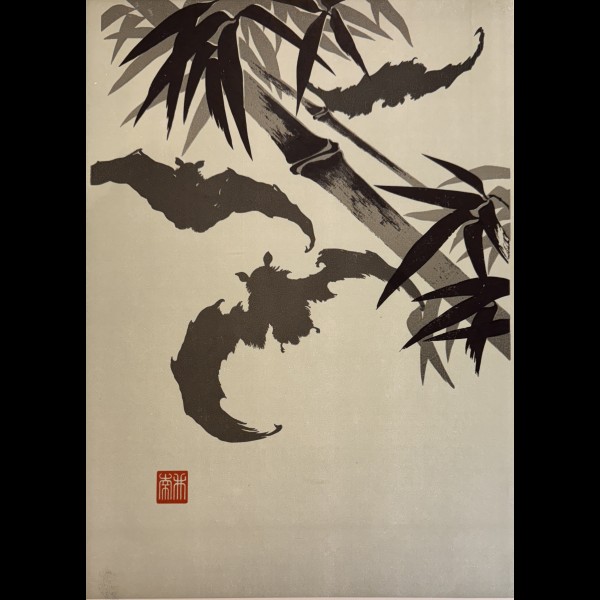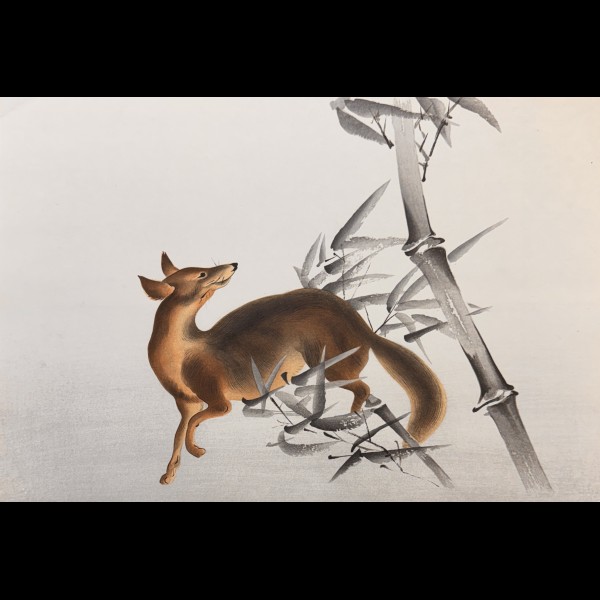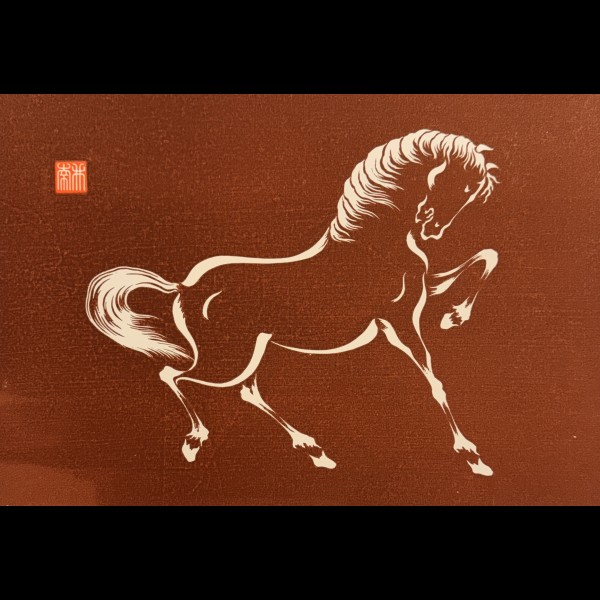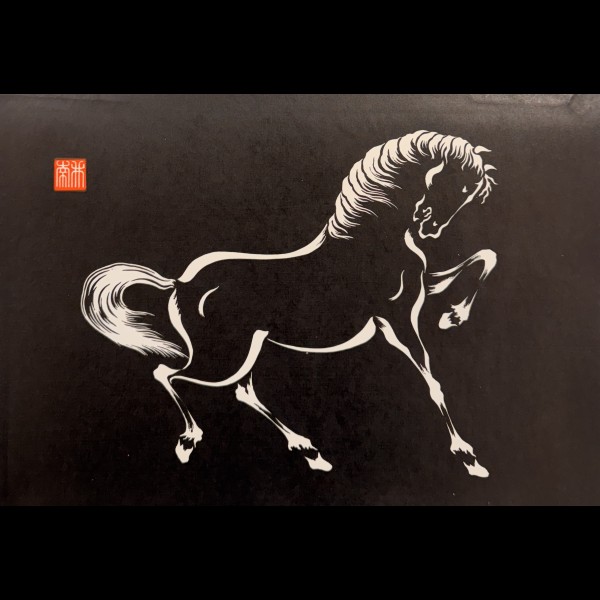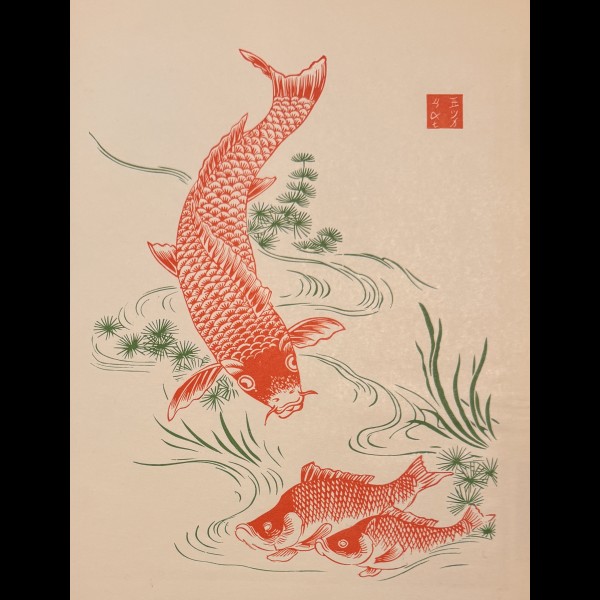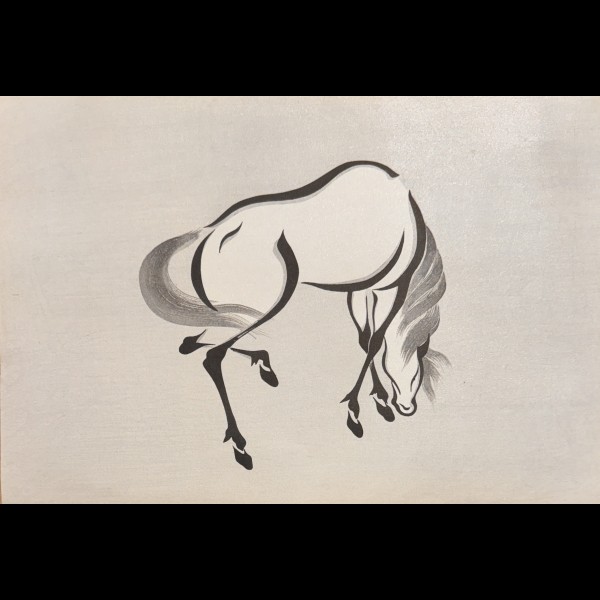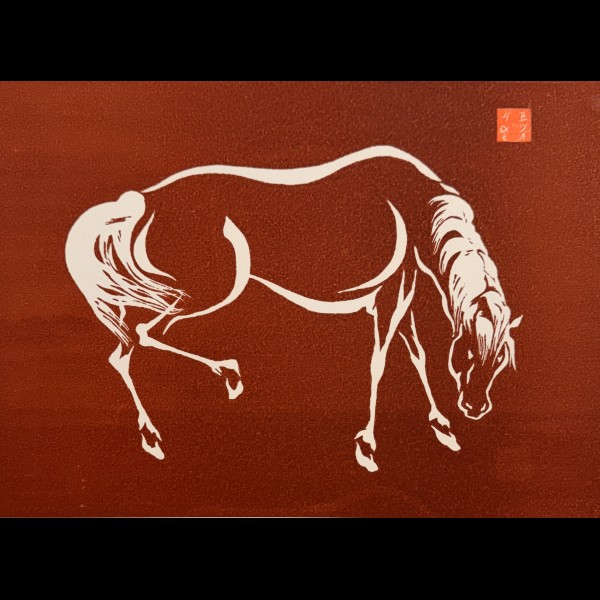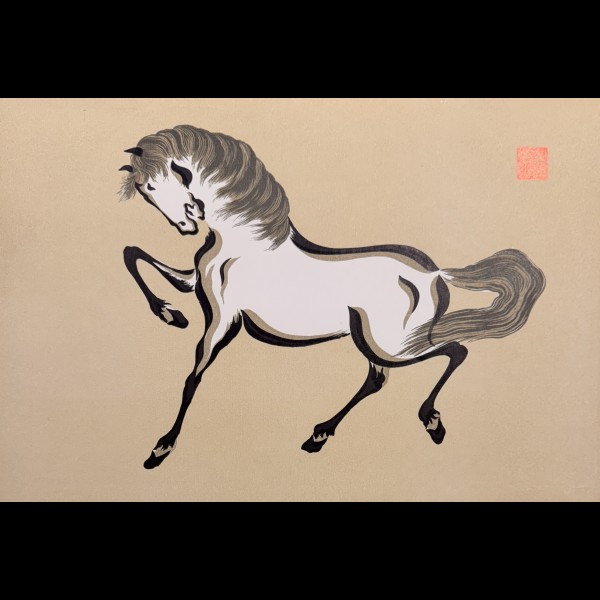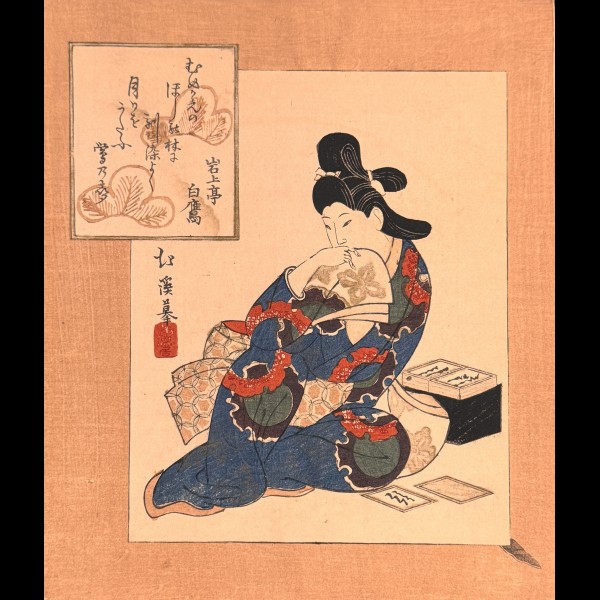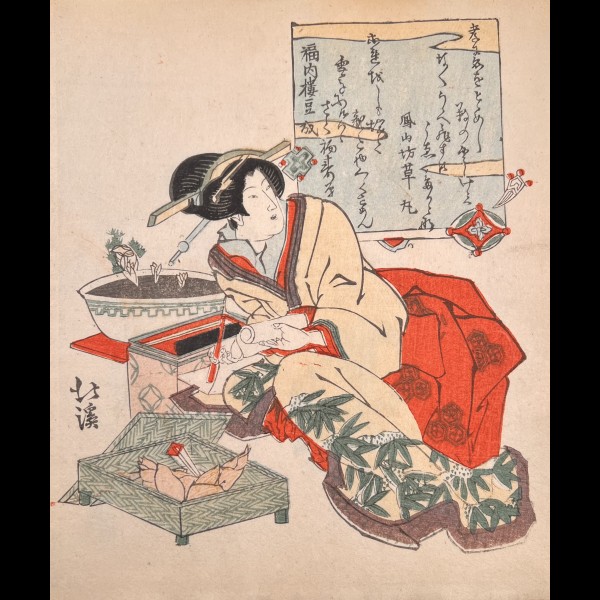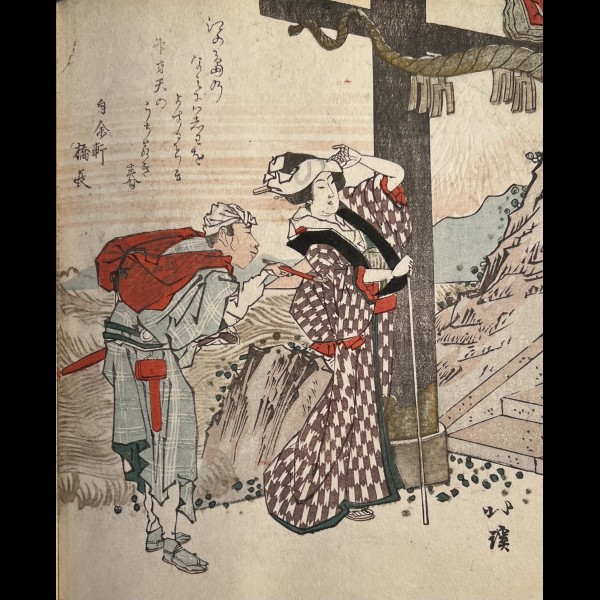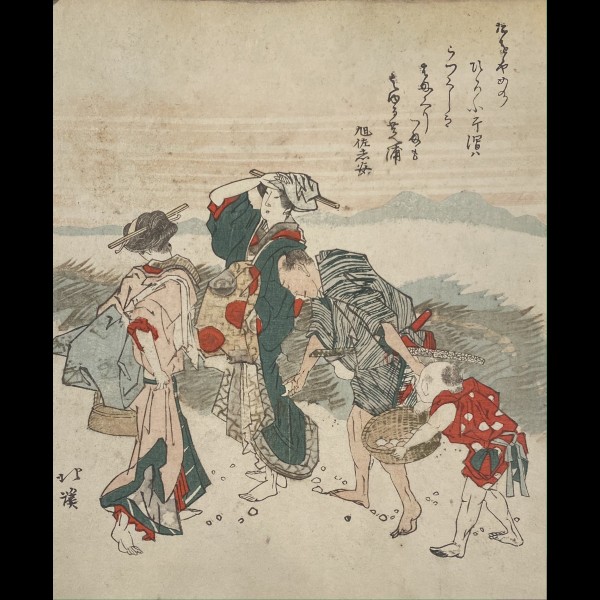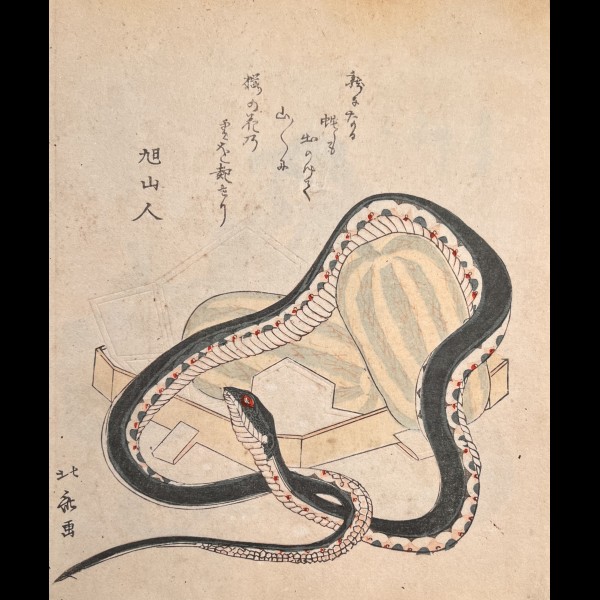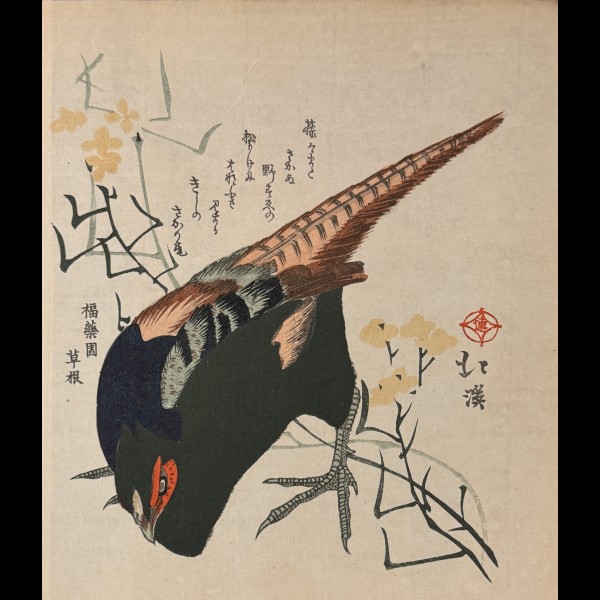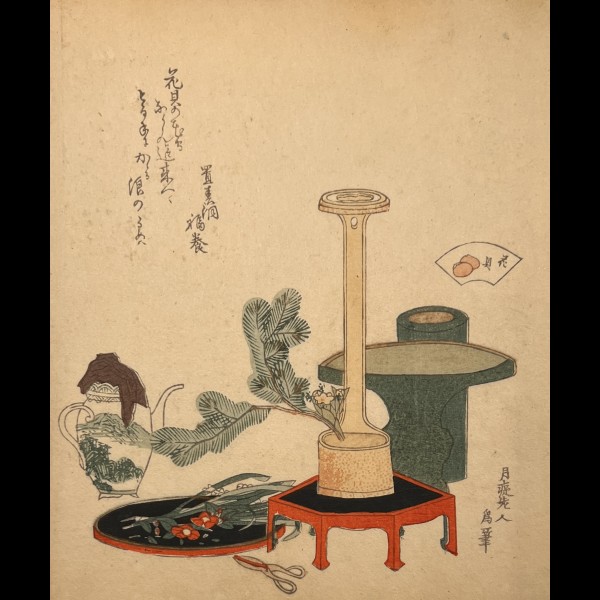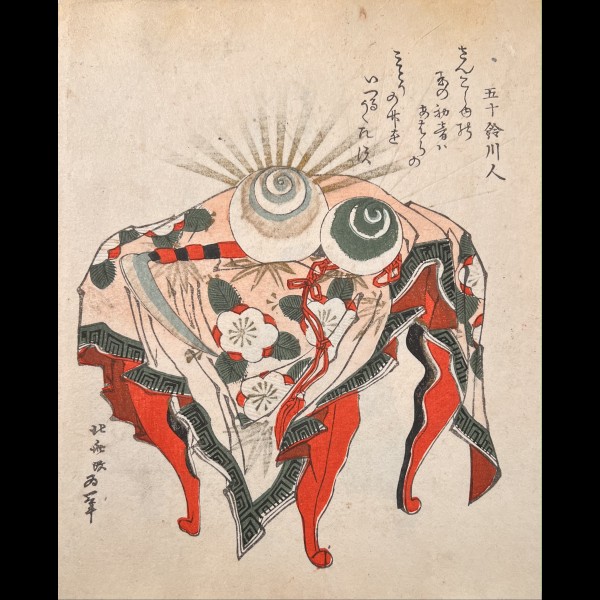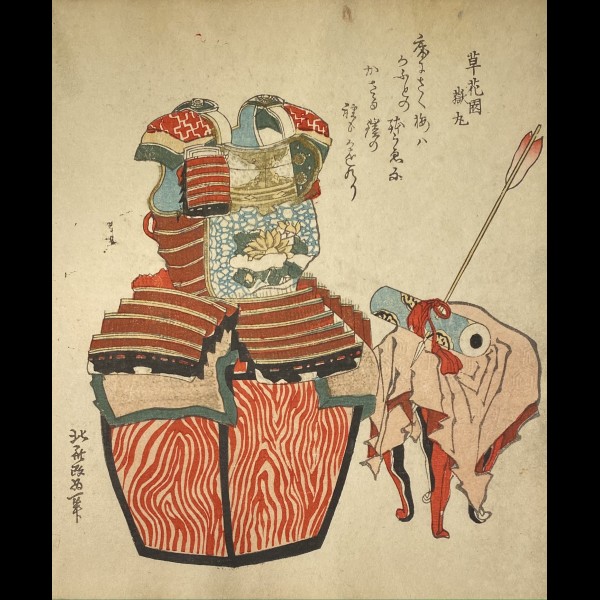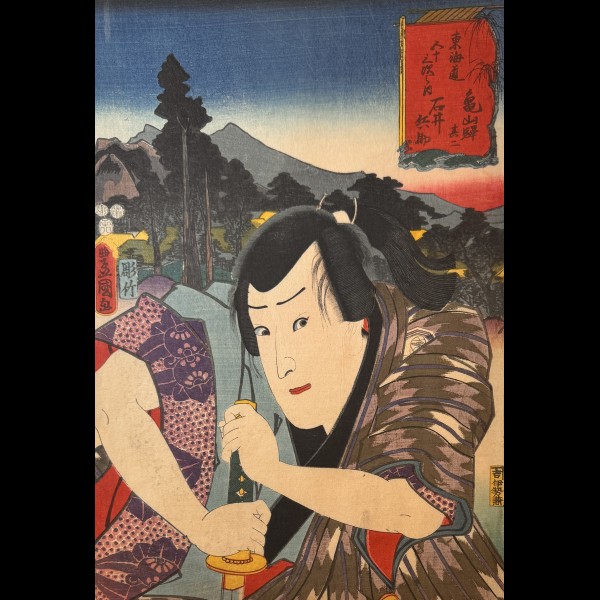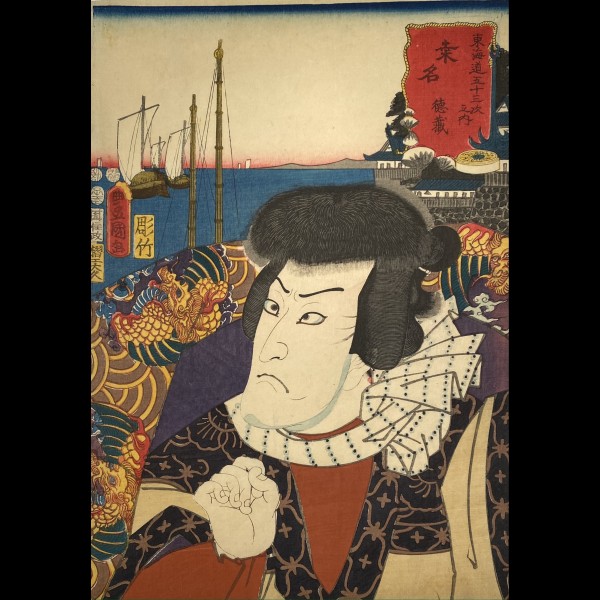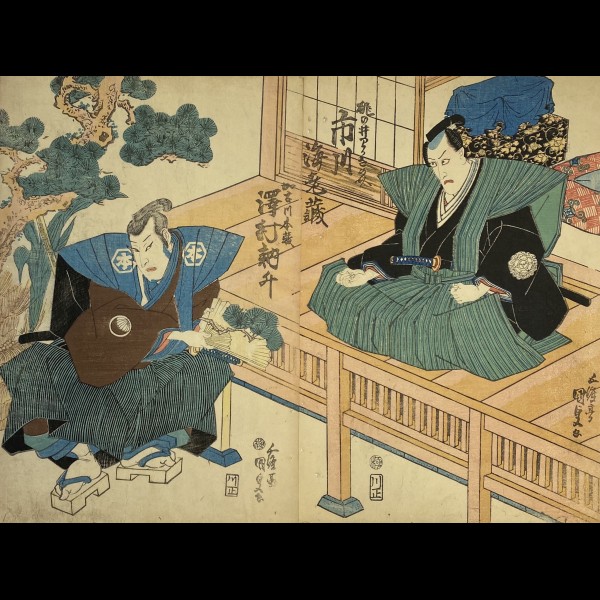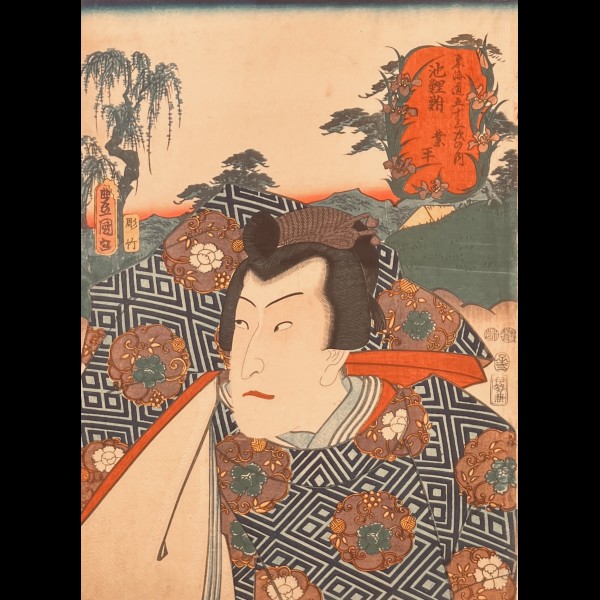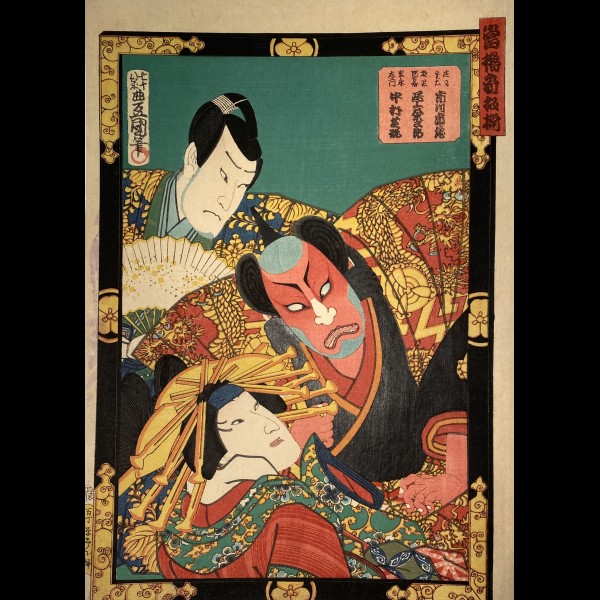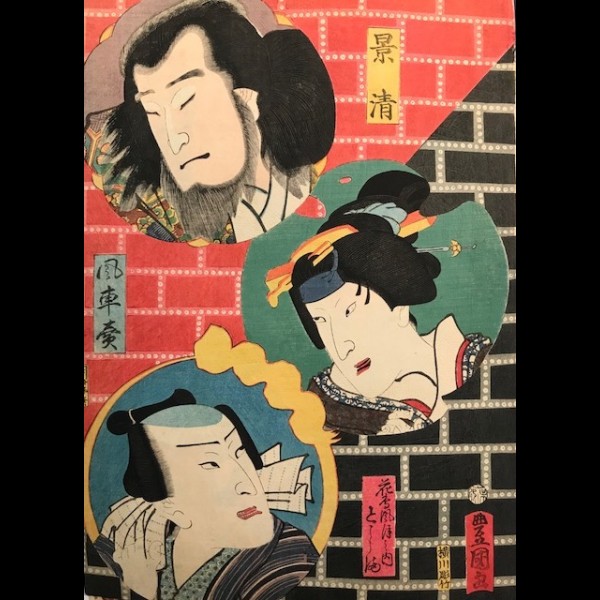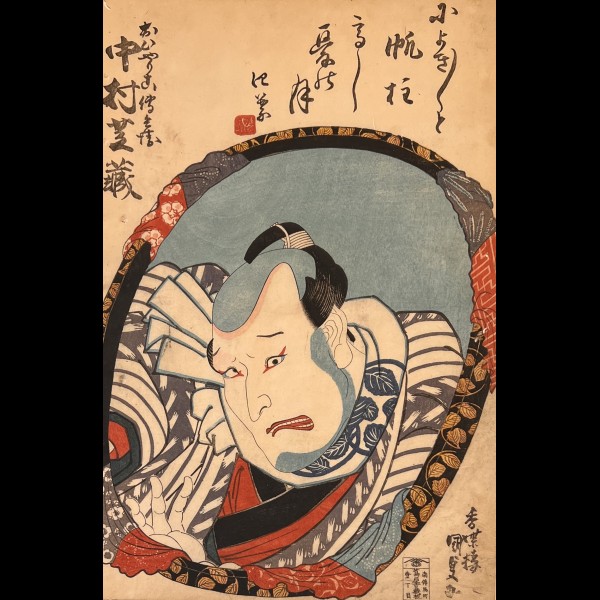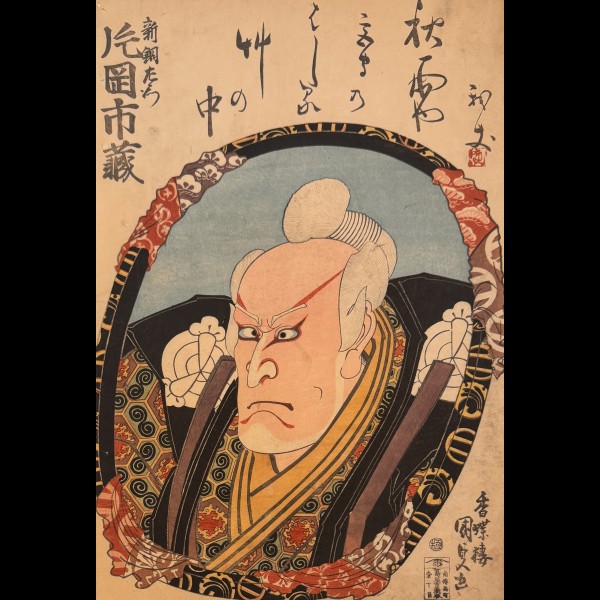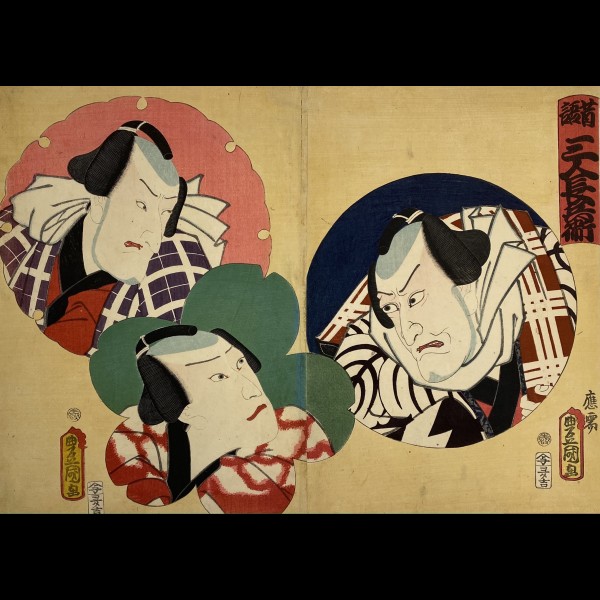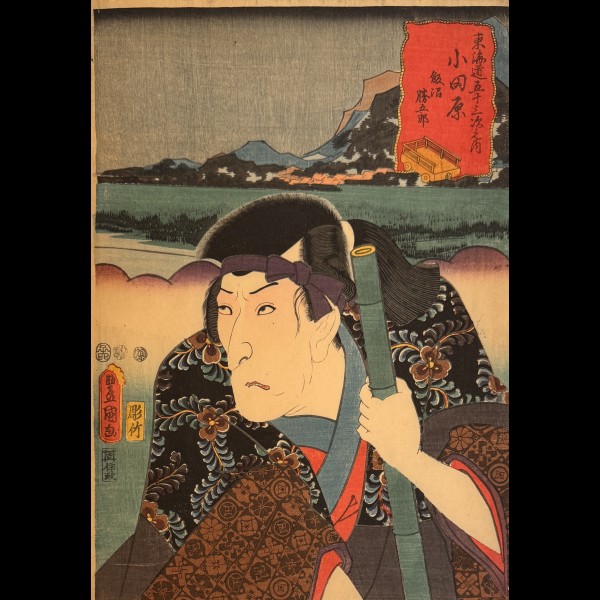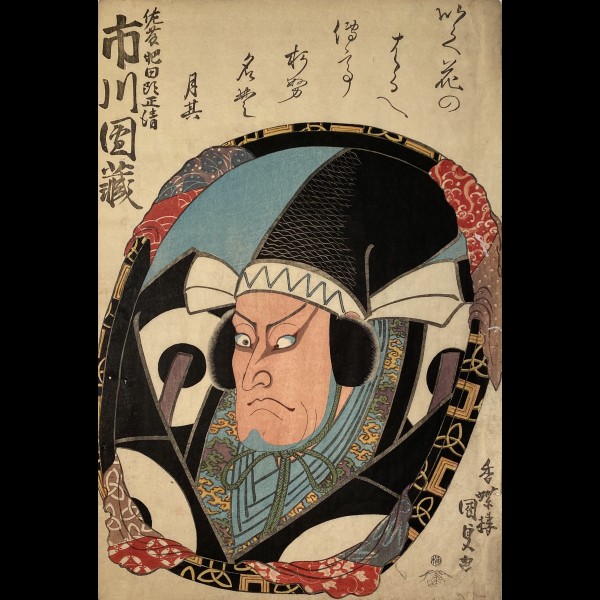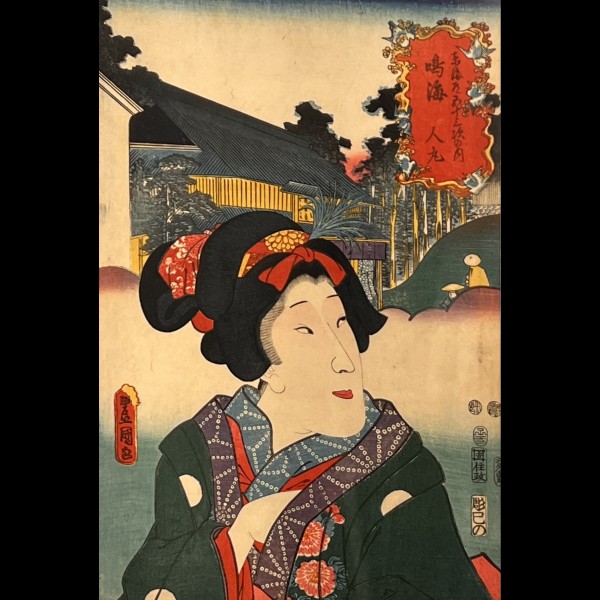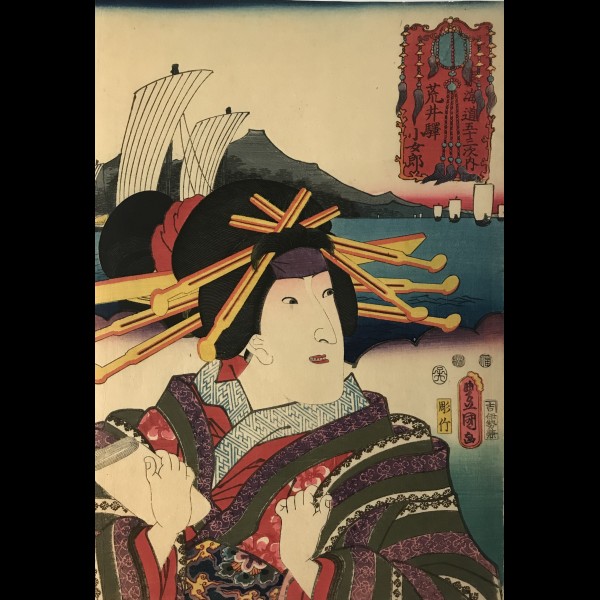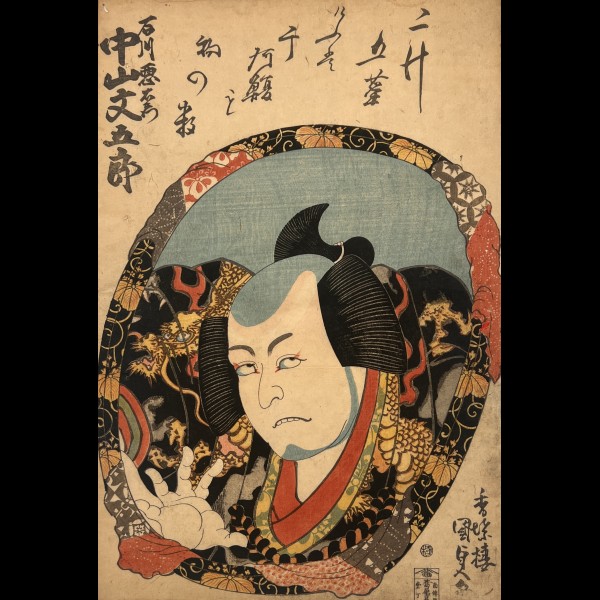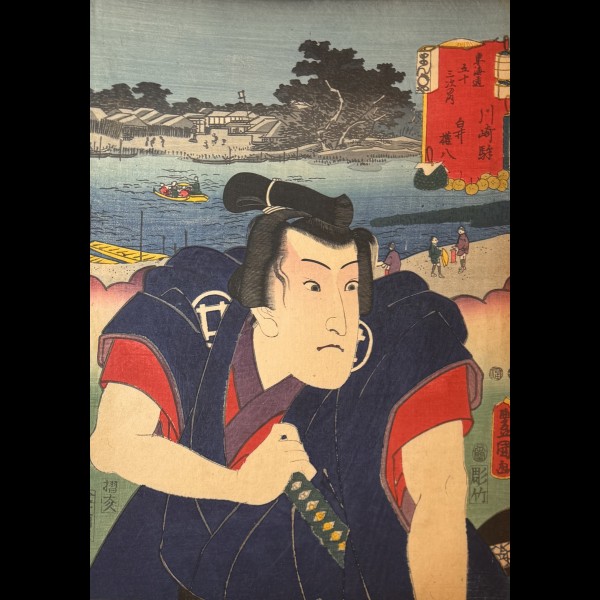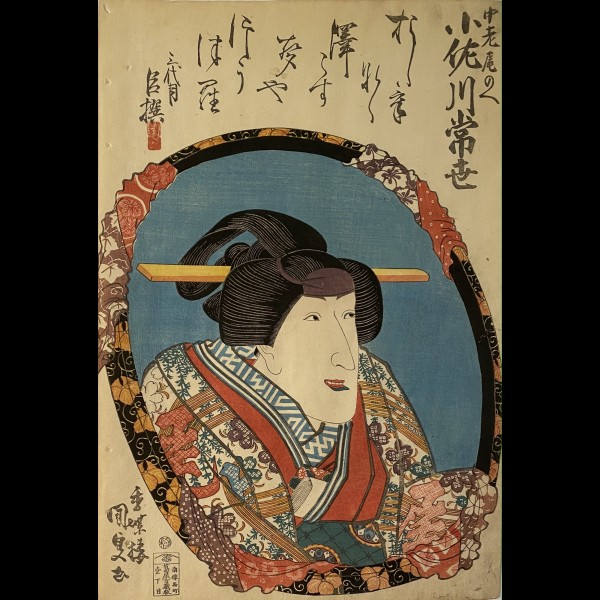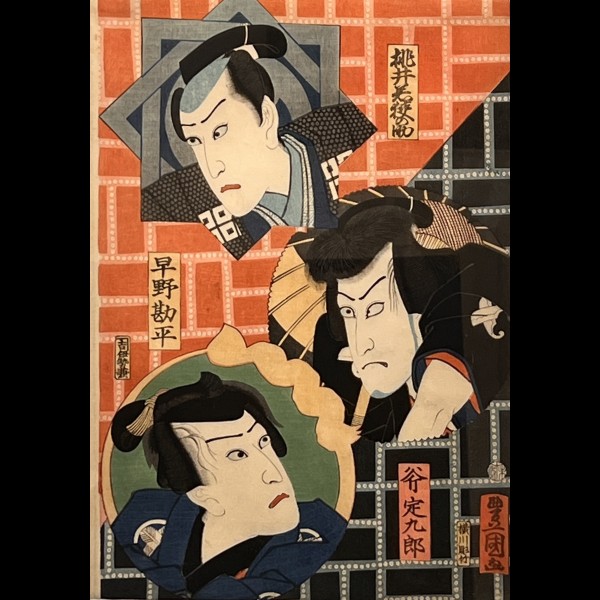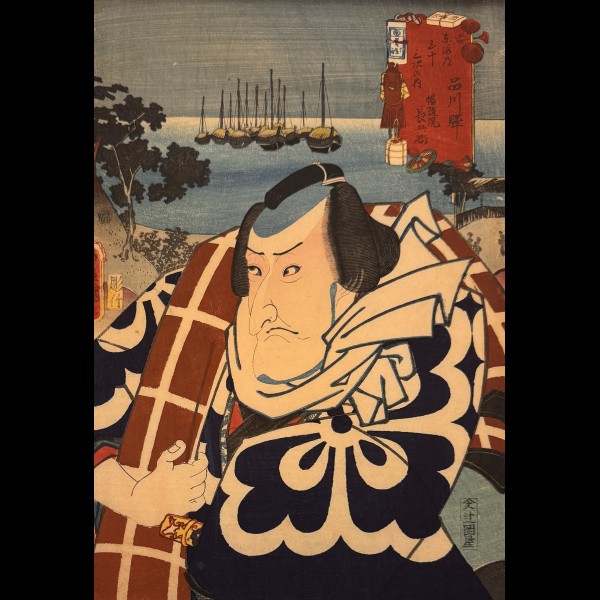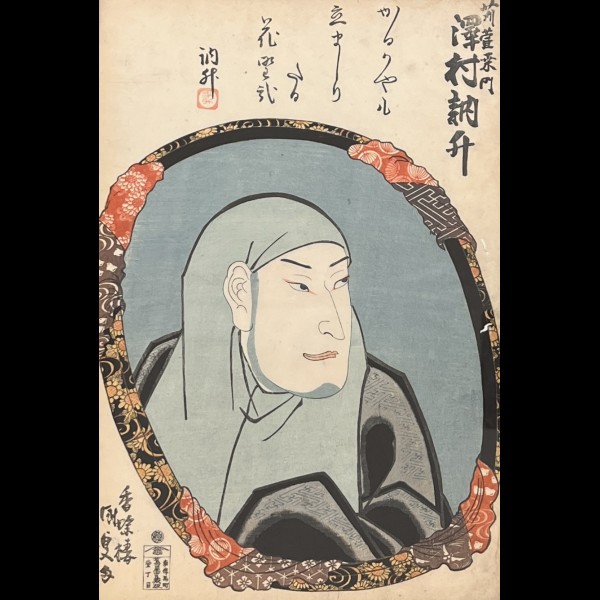YUSOKUGANGU DARUMA KOKESHI
ANONYMENice proof in very fresh colors with highlights in gold and silver.Published by Geisodo in the 11th year of the Showa era, 1936.Light uniform dustingYusokugangu embody the essence of traditional Japanese toys, reflecting the opulent ceremonies and customs deeply rooted within the imperial court and aristocracy.Among the toys often represented we come across "cat ornaments", symbolizing good luck and guardians of homes and businesses; The "pully pigeon" where a wooden pigeon moves along a string or rod; The "denden daiko", a popular hand drum often used in festive celebrations; The “koma,” or spinning tops, demonstrating both the art of design and physics in motion; The samurai's iconic "Kabuto helmets", representing their honor, valor and nobility, often displayed during the Boys' Day festival; The “daruma kokeshi dolls” embodying perseverance and luck, inspired by the founder of Zen Buddhism or the “flower arrangement” which pays homage to the traditional art of Ikebana, emphasizing harmony, balance and simplicity...
YUSOKUGANGU DARUMA KOKESHI
ANONYMENice proof in very fresh colors with highlights in gold and silver.Published by Geisodo in the 11th year of the Showa era, 1936.Small halo in the left outer border.Yusokugangu embody the essence of traditional Japanese toys, reflecting the opulent ceremonies and customs deeply rooted within the imperial court and aristocracy.Among the toys often represented we come across "cat ornaments", symbolizing good luck and guardians of homes and businesses; The "pully pigeon" where a wooden pigeon moves along a string or rod; The "denden daiko", a popular hand drum often used in festive celebrations; The “koma,” or spinning tops, demonstrating both the art of design and physics in motion; The samurai's iconic "Kabuto helmets", representing their honor, valor and nobility, often displayed during the Boys' Day festival; The “daruma kokeshi dolls” embodying perseverance and luck, inspired by the founder of Zen Buddhism or the “flower arrangement” which pays homage to the traditional art of Ikebana, emphasizing harmony, balance and simplicity...
YUSOKUGANGU
ANONYMENice proof in very fresh colors with highlights in gold and silver.Published by Geisodo in the 11th year of the Showa era, 1936.Tiny halo in the left outer border.Yusokugangu embody the essence of traditional Japanese toys, reflecting the opulent ceremonies and customs deeply rooted within the imperial court and aristocracy.Among the toys often represented we come across "cat ornaments", symbolizing good luck and guardians of homes and businesses; The "pully pigeon" where a wooden pigeon moves along a string or rod; The "denden daiko", a popular hand drum often used in festive celebrations; The “koma,” or spinning tops, demonstrating both the art of design and physics in motion; The samurai's iconic "Kabuto helmets", representing their honor, valor and nobility, often displayed during the Boys' Day festival; The “daruma kokeshi dolls” embodying perseverance and luck, inspired by the founder of Zen Buddhism or the “flower arrangement” which pays homage to the traditional art of Ikebana, emphasizing harmony, balance and simplicity...
YUSOKUGANGU DARUMA KOKESHI
ANONYMENice proof in very fresh colors with highlights in gold and silver.Published by Geisodo in the 11th year of the Showa era, 1936.Small halos in the outer borders on the left.Yusokugangu embody the essence of traditional Japanese toys, reflecting the opulent ceremonies and customs deeply rooted within the imperial court and aristocracy.Among the toys often represented we come across "cat ornaments", symbolizing good luck and guardians of homes and businesses; The "pully pigeon" where a wooden pigeon moves along a string or rod; The "denden daiko", a popular hand drum often used in festive celebrations; The “koma,” or spinning tops, demonstrating both the art of design and physics in motion; The samurai's iconic "Kabuto helmets", representing their honor, valor and nobility, often displayed during the Boys' Day festival; The “daruma kokeshi dolls” embodying perseverance and luck, inspired by the founder of Zen Buddhism or the “flower arrangement” which pays homage to the traditional art of Ikebana, emphasizing harmony, balance and simplicity...
VICTOIRE A ASAN
CHIKANOBU TOYOHARA (1838–1912)Beautiful triptych in very fresh colors formerly mounted on tabsObanNishiki-e1894 "At 3 am on July 29 a battle commenced and after five hours our troops were completely victorious" begins the text panel account of this print. Chikanobu depicts two officers leading the assault with the nation's flag held high. A Chinese canon in the foreground is turned around with its barrel down and its carriage broken. The Chinese soldiers in this print are dressed in cumbersome archaic uniforms, making them seem helpless against the Japanese troops smartly dressed in modern European style uniforms.The Battle of Seonghwan (Seikan) was the first major land confrontation of the First Sino-Japanese War. It took place on July 29, 1894 in Seonghwan, near Cheonan, in the Korean province of South Chungcheong. It is sometimes called Battle of Asan...
BATAILLE DE SEONGHWAN
CHIKANOBU TOYOHARA (1838–1912)Beautiful triptych in very fresh colors formerly mounted on tabsObanNishiki-e1894The Battle of Seonghwan (Seikan) was the first major land confrontation of the First Sino-Japanese War. It took place on July 29, 1894 in Seonghwan, near Cheonan, in the Korean province of South Chungcheong. It is sometimes called Battle of Asan...
ACTEUR DU KABUKI
YOSHITOSHI TSUKIOKA (1839 - 1892)Play : Oshu Adachi-Ga-Hara1865Nishiki-eObanProof in very fresh colors..
LUNE DE MINUIT AU MONT YOSHINO
YOSHITOSHI TSUKIOKA (1839 - 1892)Iga No TsuboneNo. 15 From the series: Tsuki No Hyakushi (The Hundred Aspects of the Moon)1889Seal: Yoshitoshi No InEngraver: EnkatsuJanuary 1886Obannishiki-eFine impression with embossing, particularly on the hair, beautiful colors, very light dusting on the outer edges. "The winged ghost that appears here is that of Sasaki no Kiyotaka, a high-ranking official at Emperor Go-Daigo's court in Kyoto. Dissatisfied with the purely nominal power granted to emperors, the ambitious Go-Daigo sought to exercise effective authority.In 1333, he overthrew the Hojo shogunate established in Kamakura and assumed political control of the country.Three years later, he found himself at odds with the Ashikaga clan. His advisors, aware of their military inferiority, agreed to retreat to give themselves time to raise troops. Among them was Kiyotaka's great rival: Kusunoki no Masashige. Kiyotaka, seeing that the emperor balked at such a renunciation, saw this as an opportunity to outmaneuver Masashige. In defiance of common sense, he declared that it was necessary on the contrary, fight. The emperor was easily convinced, and suffered a crushing defeat at the Battle of Minatogawa. The Ashikaga, now masters of the country, established themselves in Kyoto, and Go-Daigo fled to Yoshino, south of Nara, where he established a court competing with the new shogunate.As a reward for his ill-advised advice, Kiyotaka was forced to commit suicide. From then on, his spirit, refusing to take leave of the living, returned every night to float above the palace, overwhelming and terrorizing the exiled court. Seeing that no one dared to confront him, a valiant court lady named Iga no Tsubone resolved to seek him out, armed with a lantern full of fireflies. She managed to appease him, and he never appeared again.Iga no Tsubone was the wife of Kusunoki no Masashige's son, who was also driven to suicide after losing the battle he had fought against his will. From the Meiji era onward, the story of the loyal Masashige was remembered by the Japanese as a model of patriotism. As for his daughter-in-law, she proved her worth a second time when Go-Daigo was attacked by Ashikaga troops, by felling a tree to allow the empress to cross the ravine that separated her from the emperor.Here she is seen fearlessly confronting Kiyotaka's ghost. Her long hair falls to the ground, as was the fashion of the time. Engraving hair was a delicate exercise, as the thin wooden blades left protruding from the matrix to produce the lines wore down very quickly. The ghost's lips bear the blue color that ukiyo-e conventionally gave to corpses, and her eyes have a golden-yellow glow. Her clawed fingers cling to the title cartouche: Yoshitoshi, like other master printmakers, enjoyed playing with frames and borders. As for the moon, it shines through a diaphanous cloud, unless it's an eclipse—which would fit well with the fantastical theme of the print."In: ONE HUNDRED ASPECTS OF THE MOON, John STEVENSON, 2018, Ed..
MINAMOTO NO TAMETOMO
YOSHITOSHI TSUKIOKA (1839 - 1892)The great archer Chinzei Hachiro Minamoto Tametomo with two islanders from the island of Oniga-ShimaFrom the sequel: Yoshitoshi Musha buruiThe brave warriorsEdited by Maruya Tetsujirô1886Beautiful proof in very fresh colours, some scattered foxing mainly visible in the top margins, pinched fold in the upper border.Legend has it that Minamoto Tametomo (1139-1170) from a young age was an extremely skilled archer. Nearly seven feet tall and with a left arm four inches longer than his right, Tametomo used a seven and a half foot bow. Tametomo had a very wild and unpredictable character. At just fifteen years old, and without the emperor's permission, he conquered and took control of the island of Kyushu.Following the Hogen War (1156) in which he took part, Tametomo was sent into exile by the emperor on the island of Oshima (Izu province) where he gradually established himself as a local ruler.The print illustrates the moment when Tametomo discovered a nearby island, Oni-ga-shima, by following the flight of herons in a boat. The strange inhabitants were believed to be descendants of demons, but Tametomo subjugated them by impressing them with his strength.In 1170, the emperor sent the governor of Izu and his men to apprehend Tametomo. The hero sank the lead ship with a single arrow shot, but then decided to offer his bow to the Dragon King of the Sea and set his house on fire. By cutting his abdomen with his dagger, he would have initiated the tradition of honorable seppuku (ritual suicide)...
PATROUILLE AU CLAIR DE LUNE, SAITO TOSHIMITSU
YOSHITOSHI TSUKIOKA (1839 - 1892)No. 8 from the series: Tsuki no hyakushi (One Hundred Aspects of the Moon)1885Seal: TaisoObannishiki-eFine impression with embossing, some handling creases in the outer edges.Eighteen months after Hideyoshi's victorious assault on Mount Inaba, Oda Nobunaga had gained control of most of Japan, but cities and countryside teemed with potential rivals. This print again deals with the Saito clan of Mino Province, whose castle had not yet been razed, and whose loyalty to Nobunaga remained uncertain.It depicts an episode from the Taikōki, the "Chronicle of the Taikō." This title of taikō, meaning "regent," was the one Hideyoshi had assumed. Toshimitsu was a Saito general. His father, Kuranosuke, was one of the principal vassals of Akechi Mitsuhide (1526-1582). As a reward for his allegiance to Nobunaga, Mitsuhide had received a large fief; but soon, Nobunaga publicly reproached him for the destruction of Yakami Castle and the massacre of all its occupants. Wounded in his pride, he alleged in his defense that the lord of the castle had murdered his mother.At a banquet, Nobunaga—who was drunk—humiliated him again by striking his head with a fan to mock his baldness. Mitsuhide waited for the first opportunity to redeem his honor. This came in the summer of 1582 when Nobunaga, based at Honnoji Temple in Kyoto, sent the bulk of his troops to reinforce Hideyoshi, who was campaigning in the western province of Bithu. Mitsuhide marched toward Bithu at the head of his thirty thousand men, but, suddenly urging them to turn back with the cry, "The enemy is at Honnoji!" (that is, at Honnoji Temple), he ordered them to march on Kyoto. Nobunaga was taken by surprise in his headquarters and massacred.Having unsuccessfully urged Mitsuhide to renounce such treachery, Toshimitsu and his father resigned themselves to following him as loyal vassals. Here we see Toshimitsu on his reconnaissance mission: heavily armed, he advances one full moon night to the Kamo River, which is to lead the conspirators to the heart of Kyoto and to Nobunaga's hideout. His main weapon is a naginata, a spear with a long, curved blade. In the distance, the last rays of the sun still paint the sky pink.Akechi Mitsuhide's triumph would be short-lived: two weeks later, he would be defeated by Hideyoshi and killed by bandits. As for the two Saito brothers, they would flee but would be quickly captured (the rest of their adventures appear later in the series). The father would be put to death, and Toshimitsu would become a monk.Although the very low viewpoint suggests the effect of a snapshot, the composition probably owes nothing to photography. The reference is rather to be found within the ukiyo-e tradition itself: Yoshitoshi seems to be making a subtle allusion to the figures and landscapes of Hiroshige, sometimes seen from the rump of a horse. Yoshitoshi himself knew how to surprise with his compositions: this is evidenced by an early print where the left edge cuts off most of a figure. Mid-19th..
LA LUNE DE LA MONTAGNE DE KINTOKI
YOSHITOSHI TSUKIOKA (1839 - 1892)Kintoki-yama no tsukiThe boy with legendary strength, Kintoki, acting as referee in the sumo match between a monkey and a rabbit.N° 87 from the set: Tsuki No hyakushi (One Hundred Aspects of the Moon)1890ObanNishiki-eGood proof, tiny dirt on the outer borders, embossing in the white of one of the cartridges and in the rabbit's fur.Kintoki's father, a dissolute ronin, abandoned him at his birth on Mount Ashigara, not far from Fuji. He was taken in and raised by Yamauba, the woman-spirit who inhabited the mountains and embodied, in certain respects, the feminine side of primal savagery. She named him Kintarõ, the “Golden Boy”. He grew up among the mountain animals and the tengu, the birdmen who taught Yoshitsune martial arts. The child learned a lot from their contact, and quickly developed prodigious strength.One day when the warrior Yorimitsu, also called Raiko, was hunting in the vicinity of Mount Ashigara, an extraordinarily robust child, with skin the color of brick, suddenly appeared to him. He was uprooting a large tree to make a bridge that would allow the animals, his friends, to cross the river. Stunned, Yorimitsu convinced Yamauba to let him take the child to make him a hero.Renamed Kintoki, the young man became one of Raiko's four main lieutenants, proving his strength and bravery on many occasions. Yoshitoshi shows him battling monsters and demons in a multitude of prints. Perhaps the most famous example is the 1886 diptych from the Yoshitoshi manga series, where a superbly drawn spider-woman weaves her golden web around the sleeping Kintoki. The two characters in Kintoki's name mean "gold" and "time", but as with many Japanese names, the idea of a literal translation is somewhat futile. This change of name should above all be interpreted as marking the transition from boy to man.In ukiyo-e, Kintarõ is usually depicted in the company of mountain animals. We also see him as a wrestler, throwing a bear to the ground. Here he referees a parody of hand-to-hand combat between a monkey and a rabbit, two animals that we saw playing together in Sun Wukong's evocation. The color of his skin refers to his name - Kuniyoshi already liked to use shades of red to flatter the roundness of his body. Dressed as a boy, he displays the rolls of flesh which, in the minds of the Japanese and Chinese, denote a healthy child.His face beaming with happiness, Kintarõ watches his friends play. A branch of persimmon tree is placed between him and the animals: its persimmons perhaps allude to the fruits that the monkey stole from the immortals, or to the extraordinary powers of Kintaro. The fruit pigment has oxidized, taking on an interesting surface texture.The grain of the wood gives body to the rock, and the rabbit's coat is beautifully embossed.In : CENT ASPECTS DE LA LUNE, John STEVENSON, 2018, Editions Citadelles et MAZENODThe set “One Hundred Aspects of the Moon”, inspired by historical or legendary stories from China and Japan, is Yoshitoshi's most famo..
LUNE DU DRAP QU'ON BAT
YOSHITOSHI TSUKIOKA (1839 - 1892)Yugiri kinuta no tsuki #84From the sequel: Tsuki No hyakushi (The Hundred Aspects of the Moon)1890Publisher: Akiyama Buemon (Kokkeido)Seal: YoshitoshiEngraver: EnkatsuObannishiki-eGood proof, beautiful colors, a few folds in the upper border, some scattered foxing."In the nô play Kinuta (named after the roll of wood on which the sheet was beaten), a man from Kyüshü has been held in the capital for three years, awaiting a legal verdict. Nostalgic for his distant western island, he sends his servant Yúgiri to assure his wife that he will be back within the year. The wife is delighted by Yúgiri's visit, but longs for her husband. The two women hear then the sound of the sheet being beaten to wash or soften it. This is an obvious allusion to a poem from Tang China, in which a man hears despite the distance his wife beating the sheet while waiting for him. Yugiri brings a kinuta to console her mistress, who joins her in the nevertheless servile task of beating the sheet.When a new message arrives informing her that her husband will not return within a year, the woman goes crazy and dies of grief. Finally allowed to return home, the man learns of the death of his wife. His spirit appears to overwhelm him, but he manages to soothe it by chanting the Lotus Sutra - some sects believe that one can achieve salvation by repeating the name of this sutra alone.In the print, the wife beats the sheet, wrapped around her kinuta, with a wooden mallet.Obviously distant and absorbed in her work, she turns her back on Yugiri, who lowers her head. Instead of suggesting the comfort that the servant thought she brought, the image gives a feeling of overwhelm.The painted decoration of the screen, a bush of lespedezes in flower under the full moon, evokes autumn. The clear vertical lines on the left side reveal the structure of the panels. The background is otherwise totally abstract, reduced to a light gray wash which sinks into the darkness. If the servant's modern outfit is quite incongruous, the mistress wears an opulent dress worthy of a Noh costume. We glimpse a tabi, a tailor-made sock separating the big toe.The name Yügiri, which means "evening mist", is worn by many figures in Japanese culture, starting with the prince's son in Genji monogatari."In: ONE HUNDRED ASPECTS OF THE MOON, John STEVENSON, 2018, Editions Citadelles and MAZENODThe suite of “One Hundred Aspects of the Moon”, inspired by historical or legendary stories from China and Japan, is Yoshitoshi's most famous series, begun in 1885 and completed just before his death in 1892. Already at the time, each new print published was an event, the prints often selling out on the morning of their publication...
SHIKI NO HANA
TESSAI TOMIOKA (1836-1924)Engraving on wood (nishiki-e) From a suite SHIKI NO HANA (flowers of the four seasons) print Kachô-e (fauna and flora)Usual median fold, beautiful, very fresh colors, slight browning on one of the outer edges...
SHIKI NO HANA
TESSAI TOMIOKA (1836-1924)Engraving on wood (nishiki-e) From a suite SHIKI NO HANA (flowers of the four seasons) print Kachô-e (fauna and flora)Usual median fold, beautiful, very fresh colors, slight browning on one of the outer edges...
SHIKI NO HANA
TESSAI TOMIOKA (1836-1924)Engraving on wood (nishiki-e) From a suite SHIKI NO HANA (flowers of the four seasons) print Kachô-e (fauna and flora)Usual median pleat, beautiful, very fresh colors.Slight browning in the upper margin...
OMIWA
TOKURIKI TOMIKICHIRO (1902-2000)Figure from Bunraku (puppet theater)Piece: ImoseyamaVery beautiful and fresh proof bearing the red stamp and the handwritten signature of the artist.Ca.1950/70Sosaku hangaNishiki-eThis piece is one of the masterpieces of the Bunraku repertoire, whose success at the premiere in 1771 has never wavered...
LES COULEURS DE L AUTOMNE AU TEMPLE KOZANJI
TOKURIKI TOMIKICHIRO (1902-2000)From the set: The four seasons of KyotoShin-HangaNishiki-eVery beautiful and fresh proof bearing the artist's red stamp and signed in pencilCa.1950..
MONT HIEI
TOKURIKI TOMIKICHIRO (1902-2000)Fine impression, slight yellowing, ink stains on the outer left and right edges.Ca.1970/80Mount Hiei (Hiei-zan) is a mountain northeast of Kyoto, located on the border between Kyoto and Shiga Prefectures, Japan. Enryaku-ji Temple, the first of the Japanese Tendai (Chin. Tiantai) branch of Buddhism, was founded atop Mount Hiei by Saichō in 788 and quickly grew into a vast complex of temples and buildings.Tomikichiro Tokuriki was a Japanese woodblock printmaker, representing the twelfth generation of a family of Kyoto artisans. He graduated from the Kyoto City School of Fine Arts and the Kyoto City Specialist School of Painting in 1924. After World War II, he founded the Matsukyu publishing company to produce and distribute his own prints as well as Shin Hanga and Sosaku Hanga works by other artists. Tomikichiro Tokuriki was an influential figure in the contemporary print movement in Japan. He was the official artist of the Honganji Temple and was commissioned to engrave various temples throughout Japan, including the famous shrines of Ise. His prints are held in the collections of the Museum of Fine Arts, Boston, and the Museum of Modern Art, New York...
TEMPLE KIYOMIZU, KYOTO
TOKURIKI TOMIKICHIRO (1902-2000)From the series: Twelve Views of the Four Seasons of KyotoBeautiful print, numbered, lovely colors,Shin HangaNishiki-eMore than 1250 years have passed since the founding of Kiyomizu-dera Temple. Halfway up Mount Otowa, one of the mountains in the Higashiyama range in Kyoto, stands the temple, where a great number of visitors come to honor Kannon, a deity of mercy and compassion, which is why the temple is known as "Kannon's Reijo." "Reijo" means "holy place."Tomikichiro Tokuriki was a Japanese woodblock printmaker, representing the twelfth generation of a family of Kyoto artisans. He graduated from the Kyoto City School of Fine Arts and the Kyoto City Specialist School of Painting in 1924. After World War II, he founded the Matsukyu publishing company to produce and distribute his own prints as well as Shin Hanga and Sosaku Hanga works by other artists. Tomikichiro Tokuriki was an influential figure in the contemporary print movement in Japan. He was the official artist of the Honganji Temple and was commissioned to engrave various temples throughout Japan, including the famous shrines of Ise. His prints are held in the collections of the Museum of Fine Arts, Boston, and the Museum of Modern Art, New York...
FESTIVAL DE GION LE 17 JUILLET
TOKURIKI TOMIKICHIRO (1902-2000)From the set: The four seasons of KyotoShin-HangaNishiki-eVery beautiful and fresh proof bearing the artist's red stamp and signed in pencilCa.1950The Gion Matsuri in Kyoto is one of the three largest local festivals in Japan. The other two are Kanda Matsuri in Tokyo and Tenjin Matsuri in Osaka. The Gion Matsuri can be considered the largest and most spectacular. It is held every year from July 1 to 31 for the celebration of the summer solstice at Yasaka Jinja Shrine. The two key dates of this celebration take place on July 17 (Saki Matsuri or pre-festival) and July 24 (Ato Matsuri or post-festival) when all thirty-four floats crisscross the main streets of the city.Its origin dates back to the plague of 869. The emperor sent a special messenger to Yasaka Jinja, the ancient name of the shrine of Gion known to house the spirit of the brother of the sun goddess supposed to fight this evil, to pray and him To do this, he ordered the creation of sixty-six halberds representing the sixty-six provinces of the country.Once the epidemic was stopped, the inhabitants of Kyoto decided from 970, in gratitude, to organize a festival each year...
LES ACTEURS ICHIMURA UZAEMON ET ICHIMURA TAKEMATSU
YOSHIIKU OCHIAI (1833~1904)Light dirt on the outer edges.ObanNishiki-e1862..
SAWAMURA TANOSUKE
KUNICHIKA TOYOHARA (1835–1900)Representation of the tattooed Kabuki actor.Light soiling.Nishiki-eObanMeiji period print..
SCENE DE KABUKI
KUNICHIKA TOYOHARA (1835–1900)The actors Ichikawa Kuzo in the role of Wakasa Shinkichi, Sawamura Tanosuke in the role of Ane-Musume Kakesara and Nakamura Shikan in the role of Temmoku Sunosuke.Triptych formerly mounted, two small holes in the bottom of the left board, very fresh colors. Oban , nishiki-e1865..
QUATRE ACTEURS DU KABUKI
KUNICHIKA TOYOHARA (1835–1900)Piece: Mureire tazu yayoi no sogagiku1874Beautiful triptych in very fresh colors representing one of the actors wearing a kimono with skulls.Previously mounted leaves, two small losses, one in the left outer border, the other in the upper left margin, a few soft handling folds.ObanNishiki-eKunichika's success continued throughout the Meiji era. In 1874, the magazine Shinbun hentai wrote: "Color woodblock prints are one of the specialties of Tokyo and Kyōsai, Yoshitoshi, Yoshiiku, Kunichika and Ginkō are experts in this field." His contemporaries agreed that in Utagawa school: "Yoshitoshi was the specialist in impressions of warriors, Kunichika the wood engraver known for his portraits of actors and Chikanobu for court ladies. He also distinguished himself by the skillful use of color". Most artists of the time, he used strong reds and dark purples, often as background colors, rather than the softer colors used until then. These new colors were made of aniline, an imported dye. of Germany during the Meiji era (To the Japanese, the color red signifies progress and awakening in the new era of Western-style progress.)..
FEMME JOUANT DU TSUZUMISUR SUR UN POEME DE KAKAEN CHÔCHÔSHI
HOKUUN KATSUSHIKA ( Début XIXè s)Surimono Nishiki-e Shikishiban Ca.1890 Beautiful print with embossing. Poem by Kakaen Chôchôshi. The tsuzumi is a Japanese drum of Sino-Indian origin used in Noh and Kabuki theater music, but also in min'yō Japanese folk music...
OKABE
HIROSHIGE UTAGAWA ( 1797-1858 )From the series: Jimbutsu or Muraichi Tokaido(Fifty-three Stations of the Tokaido)Publisher: Murataya IchigorôCirca 1852ChubanNishiki-eOuter left border reinforced on the back, small ink stain in the sky...
HARA
HIROSHIGE UTAGAWA ( 1797-1858 )From the series: Jimbutsu or Muraichi Tokaido(Fifty-three Stations of the Tokaido)Publisher: Murataya IchigorôCirca 1852ChubanNishiki-eBeautiful colors, small ink stain in the top margin, narrower left border margin...
NISSAKA
HIROSHIGE UTAGAWA ( 1797-1858 )From the series: Jimbutsu or Muraichi Tokaido(Fifty-three Stations of the Tokaido)Publisher: Murataya IchigorôCirca 1852ChubanNishiki-eOuter left border reinforced on the back, small ink stain in the sky...
SEKI
HIROSHIGE UTAGAWA ( 1797-1858 )From the series: Jimbutsu or Muraichi Tokaido(Fifty-three Stations of the Tokaido)Publisher: Murataya IchigorôCirca 1852ChubanNishiki-e..
STATION DU TOKAIDO
HIROSHIGE UTAGAWA ( 1797-1858 )From the series: Jimbutsu or Muraichi Tokaido(Fifty-three Stations of the Tokaido)Publisher: Murataya IchigorôCirca 1852ChubanNishiki-eRemains of mounting on the back, small ink stains...
MAISAKA
HIROSHIGE UTAGAWA ( 1797-1858 )From the series: Jimbutsu or Muraichi Tokaido(Fifty-three Stations of the Tokaido)Publisher: Murataya IchigorôCirca 1852ChubanNishiki-eOuter left border reinforced on the back, small ink stain in the sail...
KANAYA
HIROSHIGE UTAGAWA ( 1797-1858 )From the series: Jimbutsu or Muraichi Tokaido(Fifty-three Stations of the Tokaido)Publisher: Murataya IchigorôCirca 1852ChubanNishiki-e..
FUGU NO BIJIN TO KURAGE NO TOMO
SHIGENOBU YANAGAWA ( 1787-1832 )Pufferfish courtesan and her jellyfish companion.SurimonoShikishibanNishiki-eCa.1890...
JOUEUSE DE SHAMISEN AJUSTANT SA COIFFURE
SHIGENOBU YANAGAWA ( 1787-1832 )ShikishibanSurmonoNishiki-eCa.1890.Proof falsely attributed to Hokusai with gold highlights.The geisha's favorite instrument, this Bijin is represented kneeling, undoubtedly on a zabuton concealed by her clothing, at her side a large ivory plectrum (bashi or bachi) used to pluck the strings of her instrument...
RAMASSAGE DES ORMEAUX ( AWABI )
SHINSAI RYURYUKYO ( 1799-1823 )Surimono, shikishiban, nishiki-e.ca.1890.Representation of one of these traditional fisherwomen of the coastal regions, who dived half-naked into the sea in search of abalones. An inexhaustible source of fascination for Westerners, these images invaded Europe during the second half of the nineteenth century. Intended for the general public, they respond to the general demand for representations of female nudes and beautiful women. Far from the ethnographic subject, these fisherwomen impose themselves in the collective imagination as courtesans of the sea, their sensual bodies delivered to the male gaze in Japan and elsewhere...
FLEURS DE CERISIER TAMBOUR ET EBOSHI
SHINSAI RYURYUKYO ( 1799-1823 )The elements represented, inspired by an episode from : "Tale of Genji", symbolize the figure of Lady Aoi (Aoi knot). Surimono, shikishiban, nishiki-e. ca.1880. Proof with embossing, printing fold...
SINGE PORTANT UN GOHEI
SHINSAI RYURYUKYO ( 1799-1823 )Monkey Dressed for a New Year's Parade Surimono Nishiki-e Shikishiban Ca.1890 In the Shinto ritual the Gohei is an object dedicated to the Kamis (Deities) consisting of two shide (strips of paper) attached to a bamboo or a wand used to purify but also to repel malicious spirits..
KOKESHI OU LES POUPEES
MOKUHANSHA MIKUMO ( 1900- ? )Sosaku hanga, numbered 41 on the back. Ca.1960..
KINUTA NO TAMAGAWA
SORI HISHIKAWA ( 1789-1818 )Surimono, Shikishibanca.1890 Light crease print.Print180x170 mm Frame 275x255 mm..
BIJIN SCULPTANT UNE FIGURE DE KAMURO
EISHI CHÔBUNSAI ( 1756–1829 )Beautiful print, a few scattered foxing.SurimonoShikishiban, nishikie, Ca.1890The Kamuro were the little girls who frequented the great courtesans. Placed in their service from an early age, they were between five and nine years old, they marched in the procession of their courtesan "elder sister" when she appeared in public, ran errands for her and accompanied her when she met clients...
OCTOBRE : ERABLE, MOMIJI
SHODO KAWARAZAKI (1889-1973)From a suite: Floral calendar of JapanCa. 1970Unsodo EditorNishiki-eShin hangaKachoeBeautiful colorsThe word "momiji" originally meant "purple foliage." Among red-leaved maples, the kaede, being the most beautiful and widespread, eventually acquired the name "momiji." It is a deciduous tree that grows wild in fields and mountains. With its magnificent purple foliage, it produces small, dark red flowers around April and May. Planted in gardens, it has given rise to numerous cultivated varieties, including one called Iroha-kaede...
AOUT: HIMAWARI, TOURNESOL
SHODO KAWARAZAKI (1889-1973)From a suite: Floral calendar of JapanCa. 1970Unsodo EditorNishiki-eShin hangaKachoeBeautiful colors, some few foxingThe HIMAWARI is of Mexican origin.It was introduced to Japan long ago and now has many varieties.It blooms between August and September.Its name, Köjitsu-aoi, comes from the fact that it was long believed that the flower turned toward the sun...
JUILLET : LOTUS, SUIREN
SHODO KAWARAZAKI (1889-1973)From a suite: Floral calendar of JapanCa. 1970Unsodo EditorNishiki-eShin hangaKachoeBeautiful colorsThe suiren literally means "sleeping lotus" because it opens at sunrise and closes at sunset. Since it opens at the hour of hitsuji (the hour of Aries), it is also called hitsuji-gusa. While it does grow wild in Japan, most cultivated varieties are of foreign origin, from India or Egypt...
SEPTEMBRE, CAMPANULE OU KIKYO
SHODO KAWARAZAKI (1889-1973)From a suite: Floral calendar of JapanCa. 1970Unsodo EditorNishiki-eShin hangaKachoeBeautiful colors, some tiny foxingTHE KIKYO is a celebrated autumn flower, being counted as one of the seven representative autumn flowers under the name of Asagao. As a matter of fact, however, it begins to bloom in summer and comes to its end at the beginning of autumn. Its flower is campanulate and five-serrated. Though it is generally deep purple, yet it is sometimes white, especially when the plant is cultivated.• Of the cultivated kinds, the most well-known are Hina-kikyo, Sawa-kikyo, Iwa-kikyo and Chishima-kikyo. And these cultivated ones, thanks to quick culture, appear on the market about May and June...
JUIN : SHAKUYAKU
SHODO KAWARAZAKI (1889-1973)From a suite: Floral calendar of JapanCa. 1970Unsodo EditorNishiki-eShin hangaKachoeBeautiful colorsThe shakuyaku is a flower related to the peony. Although it thrives in China today, it originated in Northeast Asia. It was imported from China to Japan. Originally, it was cultivated as a medicinal plant. In spring, it develops a pretty bud and blooms around June...
OEILLETS
SHODO KAWARAZAKI (1889-1973)From a suite: Floral calendar of JapanCa. 1970Unsodo EditorNishiki-eShin hangaKachoeGood proof, beautiful colors, tiny scattered foxing...
DOJOJI
MATSUNO SOFU ET HIDEYO ( ACTIFS XXEME S)Red Wig Dancefrom the suite: Jūnikagetsu nōga suri" (Twelve months of Noh theatre)1975ObanShin-hangaNishiki-eBeautiful colors.Perhaps no temple is more popular than Dojoji Temple in the history of Japanese public entertainment, but no reference is made to it in this drama. The drama deals with the metamorphosis of a woman into a dragon. The print illustrates the moment when the woman, having thrown her eboshi hood with her fan, is about to be consumed.The characters inscribed in the seal mean:"Other than cherries, nothing but pines."..
KIKU JIDO
MATSUNO SOFU ET HIDEYO ( ACTIFS XXEME S)From the suite: Jūnikagetsu nōga suri" (Twelve months of Noh theatre)1975ObanShin-hangaNishiki-eBeautiful colors.He was one of the favorite subjects of Emperor Mu, until the day when, falling into disgrace following the machinations of a rival, he was banished to the mountains. Upon parting ways with him, Emperor Mu took pity on him and taught him a line from the Lotus Sutra to ensure his safety. Kikujidou, exiled to a valley of blooming chrysanthemums, spent his days writing this Buddhist saying on chrysanthemum leaves, and when one day he immersed those leaves in the stream in the valley, the water turned into an elixir of 'immortality...
HANAGATAMI
MATSUNO SOFU ET HIDEYO ( ACTIFS XXEME S)The Basket of Flowers' Dancefrom the suite: Jūnikagetsu nōga suri" (Twelve months of Noh theatre)1975ObanShin-hangaNishiki-eBeautiful colors, printing with embossing.Hanagatami or The Basket of Flowers, narrates an idyll, although not recorded in the annals, between a prince who later acceded to the throne as the twenty-sixth emperor of Japan and the daughter of a provincial lord.Princess Teruhi-no-Mae imitates here the behavior of the emperor who adored his ancestors by offering flowers to their souls in the village of Ajimano before his accession to the throne.The characters inscribed in the seal mean:"Maple Leaves Scattered in the Wind"..
TEMPLE KAJU-JI
MASAO IDO ( 1945-2016 )From the sequel: One Hundred Famous Views of KyotoTwo small marks from an old mount in the upper border, tiny trace in the lower margin.1950Sosaku HangaNishiki-eMasao Ido was a renowned contemporary printmaker, renowned for his serene and timeless depictions of Japanese landscapes, particularly Kyoto. Born in northeastern China and later settled in Japan, he studied under Yoshida Koho and mastered the traditional technique of woodblock printing.His works combine traditional aesthetics with a modern sensibility, characterized by rich textures, harmonious colors, and an ability to convey serenity and depth...
FLEUR DE LOTUS
MASAO IDO ( 1945-2016 )From the series: Kyoto Seasonal Flower CalendarSigned and numbered printCirca 2000Sosaku HangaNishiki-eMasao Ido was a renowned contemporary printmaker, renowned for his serene and timeless depictions of Japanese landscapes, particularly Kyoto. Born in northeastern China and later settled in Japan, he studied under Yoshida Koho and mastered the traditional technique of woodblock printing.His works combine traditional aesthetics with a modern sensibility, characterized by rich textures, harmonious colors, and an ability to convey serenity and depth...
ADASHINO NENBUTSU-JI A SAGANO
MASAO IDO ( 1945-2016 )From the series: One Hundred Famous Views of KyotoTwo small marks from an old mount in the top margin, and a tiny pinch of the paper in the top and bottom borders.The print depicts Adashino Nenbutsu-ji in Sagano, one of the ten scenic spots in the area.Under the moonlight, the temple grounds are illuminated by countless candles during the Manto-e Bon festival, when people gather to pay homage to the departed.The artist wrote about this print: "Halfway up the gentle slope that continues from Giō-ji Temple to Torii-moto, a stone staircase on the left leads to several small stone statues of Jizō that welcome visitors.Passing a path surrounded by trees, one arrives at a small hall, in front of which are lined up countless stone Buddhas.Every year, during the Bon Festival Manto-e, many people come to light candles.I wanted to express the atmosphere where the soft candlelight and the pale moonlight delicately illuminate the stone Buddhas.Sometimes, the flames flickering in the wind seem to convey the feelings of forgotten souls."Sosaku HangaNishiki-eMasao Ido was a renowned contemporary printmaker, renowned for his serene and timeless depictions of Japanese landscapes, particularly Kyoto. Born in northeastern China and later settled in Japan, he studied under Koho Nishikawa and Yoshida Koho and mastered the traditional technique of woodblock printing.His works combine traditional aesthetics with modern sensibilities, characterized by rich textures, harmonious colors, and an ability to convey serenity and depth...
TEMPLE D'OTA
MASAO IDO ( 1945-2016 )From the sequel: One Hundred Famous Views of KyotoTwo small marks from an old collage in the top margin.Ten Views of Rakuhoku - Ōta Shrine. This small local shrine is where people come to pray for good health, happiness in marriage, and even success on stage. The kakitsubata irises at Ōta Shrine bloom twice, in May and early June. The pond was originally part of a marsh known as Ōta no Sawa. The island in the center of the pond is called the "Floating Island," after the Chinese Island of the Immortals. This shrine is associated with Nasu Yoichi, a military commander active during the Genpei War (1185).Sosaku HangaNishiki-eMasao Ido was a renowned contemporary printmaker, renowned for his serene and timeless depictions of Japanese landscapes, particularly Kyoto. Born in northeastern China and later settled in Japan, he studied under Koho Nishikawa and Yoshida Koho and mastered the traditional technique of woodblock printing.His works combine traditional aesthetics with modern sensibilities, characterized by rich textures, harmonious colors, and an ability to convey serenity and depth...
LE PONT D'HIROSAWA
MASAO IDO ( 1945-2016 )From the sequel: Kyoto Hakkei (One Hundred Views of Kyoto)Sagano Jukke (Ten Views of Sagano)C. 1990/2000Sosaku HangaNishiki-eIdo Masao, deeply moved by the place, shared these few secrets:"For me, Hirosawa Pond is a place full of memories, the place where I began my journey. I have visited it countless times, from my apprenticeship to the present day.Through the seasons, I have continued to admire its beauty. On a narrow island jutting into the pond stand a small shrine and a stone statue of the Thousand-Armed Kannon.The snow that falls overnight is magnificent. The tranquility of the snowy landscape is particularly striking. Forgetting the cold, I draw while thinking back to my youth, when I came here many times.You can hear the songs of waterfowl nearby."Masao Ido was a renowned contemporary printmaker, renowned for his serene and timeless depictions of Japanese landscapes, particularly Kyoto. Born in northeastern China and later settled in Japan, he studied under Yoshida Koho and mastered the traditional technique of woodblock printing.His works combine traditional aesthetics with modern sensibilities, characterized by rich textures, harmonious colors, and an ability to convey serenity and depth...
POUPEES KYO WARABE MASABI
YAMAOKA SHINPEI ( ACTIF CA.1930-1960 )Ca.1930Sosaku hangaNishiki-eNice proof...
SAIKAI YOHA KIGEN
SHOZAN HAYAKAWA ( 1850-1892 )The Origin of the Turbulence in the Western Sea Are among other things represented, with their name appearing in a cartridge :Prince Komatsu Akihito, Kawamura Sumiyoshi, Prince Arisugawa Taruhito, Sanja Sanetomi, Iti Hirobumi, Kido Takayoshi, zkubo Toshimichi, Iwakura Tomomi, Kuroda Kiyotaka, Yamagata Aritomo, Itagaki TaisukeEtō Shinpei, Saigi Takamori,Kirino ToshiakiPublisher: Kobayashi Tetsujirō (Maruya Tetsujirō)Meiji era1877 (Meiji 10) Beautiful triptych in very fresh colors formerly joined together, central fold...
REUNION A TOKYO DES PREMIERS FONCTIONNAIRES PREFECTORAUX
TOSHINOBU YAMAKAZI (1857 – 1886 )Meeting in Tokyo of the first prefectural officials elected to form the constitutional,Meiji1880Nishiki-eBeautiful triptych in very fresh colors formerly joined together, central fold...
DAI NIPPON KAIRIKUGUNICHIRAN
TOSHINOBU YAMAKAZI (1857 – 1886 )Overview of the Japanese Naval ForceApril 21, 1878Meiji1878Beautiful triptych in very fresh colors formerly joined together, central fold...
SCENE DE LA GUERRE SINO-JAPONAISE
KIYOCHIKA KOBAYASHI (1847-1915 )Tanaka Ishimatsu fights desperately in Sanchiaoyung, Taiwan1895 (Meiji 28)Part of a triptych representing the hero on the lookout under the moonlight.Beautiful impression, light soiling and soft creases in the upper margin.ObanNishiki-e..
LA PROPOSITION DE L'EMPEREUR
MIYATA MASAYUKI ( 1926-1997 )From the sequel: The Tale of the Bamboo CutterVery fine impression, signed and numbered 90/300, silver highlights in some areas, and minor foxing in the outer borders.A Japanese artist specializing in kiri-e (paper cutting), he was selected in 1995 as the United Nations' official artist of the year.He created illustrations for modern publications of classic Japanese literature, including Oku no Hosomichi, The Tale of Genji, and The Tale of the Bamboo Cutter.Some of his works are still published today by Kodansha International...
GOGO
SENTARO IWATA ( 1901-1974 )Gogo or AfternoonCa.1970Beautiful impression with fresh colors and embossed effects on the eyelid and collar.Soft handling creases in the outer edges.Iwata Sentarō was born in Kurofune-cho, Asakusa-ku, Tokyo (now Kotobuki, Taito-ku, Tokyo).He began his career in Kyoto as a disciple of Kikuchi Keigetsu, a Japanese painter.Returning to Tokyo in 1919, he became a protégé of Hakubunkan and produced illustrations for its magazine "Kodan Magazine," and later for "Bungei Club."At this time, around 1920, he became a disciple of Ito Shinsui.In 1961, he was awarded a medal with a purple ribbon for his work...
DEUX CHEVAUX GALOPANT
ARTISTE SOSAKU HANGASosaku Hanga print of the 50sBeautiful print on a slightly micaceous background, short tear in the lower border.Nishiki-eOban..
CHAUVES-SOURIS
ARTISTE SOSAKU HANGASosaku hanga from the 1960sNice print, tiny speck of soiling in the lower left border.Nishiki-e..
RENARD ET BAMBOU
ARTISTE SOSAKU HANGASosaku Hanga print of the 50sNice print, crease in the upper left corner.Nishiki-eOban..
CHEVAL BROUTANT
ARTISTE SOSAKU HANGASosaku Hanga print of the 50sNice proof on a micaceous backgroundNishiki-eOban..
CHEVAL SUR FOND ROUGE BROUTANT
ARTISTE SOSAKU HANGASosaku hanga from the 1960sNice print.Nishiki-e..
HISHIKAWA MONOROBU ZU
HOKKEI TOTOYA (1780–1850)Surimono in the Style of Hishikawa Moronobu Shikishiban, Nishiki-e ca.1890...
MENG ZONG ( MÔ SÔ )
HOKKEI TOTOYA (1780–1850)Geisha with a box of bamboo shootsSurimono from a suite of 24: Paragons of Filial PietyShikishiban, Nishiki-e,ca.1890Beautiful fresh color print..
ENTREE DU TORII D'ENOSHIMA
HOKKEI TOTOYA (1780–1850)Surimono Shikishiban, Nishiki-e,ca.1890 Nice print with few heightened gold, Mount Fuji sketched by the use of embossing.A couple is represented here in front of the gate (torii) leading to the Shinto shrine on the promontory of Enoshima. The bag on the man's back and the woman's outfit wearing the ageb'shi (headdress protecting her elaborate bun), suggests that they are travelers from the neighboring city of Edo.The geometric pattern of the woman's kimono (yagasuri) is a kind of ikat weave reproducing the distinctive design of the arrow feather (ya). This model initially worn by women of the warrior class and then adopted by the servants of the Court of the Shoguns spread in the 19th century among the women of the city of the merchant class...
RAMASSEURS DE COQUILLAGES, KAIZUKUSHI
HOKKEI TOTOYA (1780–1850)Some scattered foxing.SurimonoNishiki-eShikishibanCa.1890..
SERPENT ET MELONS DU CHOMON-JÛ
HOKKEI TOTOYA (1780–1850)From the set: Washo Kurabe (a comparison of Japanese books) Creation of Hokkei, falsely signed and attributed to Hokusai. ca.1890, Shikishiban, Nishiki-e Printing with embossing, some tiny foxing..
FAISAN
HOKKEI TOTOYA (1780–1850)Surimono from the series of thirty-six creatures (Sanjûrokkin Tsuzuki), Shikishiban, Nishiki-e ca.1890...
IKEBANA OU LA PREPARATION DU BOUQUET
HOKUSAI KATSUSHIKA (1760-1849)ShikishibanSurmonoNishiki-eCa.1890...
MARIONNETTISTE TENANT UNE POUPEE SUR UN JEU DE GO
HOKUSAI KATSUSHIKA (1760-1849)Surimono, ShikishibanEdition Akashi ca.1890 Embossed print..
LES PERLES DE LA MAREE BASSE ET LA SCYTHE DES FUJIWARA ( KANJU MANJU FUJI NO MAKIKAMA )
HOKUSAI KATSUSHIKA (1760-1849)Proof with embossing and gold highlights.SurimonoSmall freckle at the top. Shikishiban, nishikieCa.1890 From continuation: the four important clans of Japan (Shisei No Uchi). The beads of the ebbing tide are laid next to the Scythian of the Fujiwara clan on a silk fabric, decorated with plum blossoms, draped over a three-legged table. Two poems accompany the composition. The Fujiwara clan ( Fujiwara-shi) is a Japanese nobility family from which many emperors were descended during the Nara and Heian periods, from the 8th to the 12th centuries of our calendar. Branches of the clan continued to play an important role in the Japanese aristocracy until modern times. The name Fujiwara means "wisteria enclosure"...
SUTRA ET ARMURE D'AVALOKITESVARA A MOTIF DE CHRYSANTHEME
HOKUSAI KATSUSHIKA (1760-1849)Armor depicting the Tachibana clan, one of the four powerful families of the Japanese nobility (Kuge) from the Nara era to the beginning of the Heian era. From the series: Four types of existence (Shishô no Uchi) Poem by Sôkaen Takemaru Proof with gold highlights on the armor and embossingSurimono Nishiki-e ShikishibanTwo tiny freckles at the top, small ink smear to the left of the armor..
ICHIMURA UZAEMON XII DANS LE RÔLE DE ISHII HYOSUKE
KUNISADA ( TOYOKUNI III DIT ) UTAGAWA (1786 - 1864)The Fifty-three Tokaido Stations (Tokaido Gojusan Tsugi no Uchi) Station 47 : KameyamaEditor : Iseya Kanekichi Oban, Nishiki-e 1852 Very fresh colors, some dirt on the arms...
ONOE KIKUGORO III DANS LE ROLE DE TOKUZO
KUNISADA ( TOYOKUNI III DIT ) UTAGAWA (1786 - 1864)Station 43: Kuwana From the suite of: Fifty-three Tokaido stations (Tokaido Gojusan Tsugi no Uchi) Censor: Mera Watanabe Editor: Sumiyoshiya Masaguro Oban, Nishiki-e 1852 Very nice and fresh print with embossing..
DEUX ACTEURS DU KABUKI
KUNISADA ( TOYOKUNI III DIT ) UTAGAWA (1786 - 1864)Small holes on the left and right edges, slight dirt on the lower corners.Kiwame Seal (1790-1845) Publisher: Kawa-Sho (Eisendo) Nishiki-e, oban..
BANDO TAKEJA BURO I DANS LE RÔLE DE NARIHIRA
KUNISADA ( TOYOKUNI III DIT ) UTAGAWA (1786 - 1864)The Fifty-three Tokaido Stations (Tokaido Gojusan Tsugi no Uchi) Station 40 : ChiryûEditor : Iseya Kanekichi Oban, Nishiki-e 1852 Nice and fresh proof...
ICHIKAWA KHIZO III, ONOE EIZABURO ET NAKAMURA SHIKAN IV
KUNISADA ( TOYOKUNI III DIT ) UTAGAWA (1786 - 1864)Respectively in the roles of Shoji Shigetaba, the courtier (Yokun) Akoya, and Iwanaga SaemonNext: Atari Yagura Kanban Zuroi (The successes of the big players).1863.Oban, Nishiki-e.Very nice and fresh proof with embossings...
NAKAMURA FUKUSUKE I
KUNISADA ( TOYOKUNI III DIT ) UTAGAWA (1786 - 1864)Actor Nakamura Fukusuke I in three performances, as Kagekiyo, as Toshimon in Kachôfûgetsu ( Kachôfûgetsu Noushi Toshima ) and as a seller, Edo period, Editor Iseya Kamekichi, Oban, Nishiki-e..
NAKAMURA SHIKAN I DANS LE ROLE DE OHIYARIKO DENBEI
KUNISADA ( TOYOKUNI III DIT ) UTAGAWA (1786 - 1864)From the series: Portraits of actors reflected in mirrors. ( Imayo Oshi-e Kagami )Publisher: Tsutaya Kichizo Censor: Kiwame Oban, Nishiki-e 1832 Very fresh colors, slight marginal dustiness, some galleries of worms and pinholes along the borders...
OTANI TOMOEMON IV DANS LE RÔLE DE WASHIZUKA DAIHACHI
KUNISADA ( TOYOKUNI III DIT ) UTAGAWA (1786 - 1864)Station 44: YokkaichiFrom the sequel to: Fifty-three Stations of the Tokaido (Tokaido Gojusan Tsugi no Uchi)Publisher: Izutsuta ShokichiCensor: Kinugasa MurataOban, Nishiki-e1852Very fresh colors..
KATAOKA ICHIZO DANS LE ROLE DE SHINDO SAEMON
KUNISADA ( TOYOKUNI III DIT ) UTAGAWA (1786 - 1864)From the series: Portraits of actors reflected in mirrors. ( Imayo Oshi-e Kagami )Publisher: Tsutaya Kichizo Censor: Kiwame Oban, Nishiki-e 1832 Very fresh colors, slight dustiness, some galleries of worms and pinholes along the borders...
HISTOIRES ANCIENNES : TROIS HOMMES NOMMES CHOBEI
KUNISADA ( TOYOKUNI III DIT ) UTAGAWA (1786 - 1864)Beautiful printing in very fresh colors Edo period 1859Nishiki-e, oban..
MORITA KAN'YA XI DANS LE RÔLE DE LINUMA KATSUGORO
KUNISADA ( TOYOKUNI III DIT ) UTAGAWA (1786 - 1864)Station: OdawaraFrom the sequel to: Fifty-three Stations of the Tokaido (Tokaido Gojusan Tsugi no Uchi)Publisher: Sumiyoshiya MasagorōEngraver: Yokokawa Takejirō (Hori Take)1852 (Kaei 5)Very fresh colors..
L'ACTEUR ICHIKAWA DANZO V DANS LE ROLE DE SATO HIDA NO KAMI MASAKIYO
KUNISADA ( TOYOKUNI III DIT ) UTAGAWA (1786 - 1864)From the series: Portraits of actors reflected in mirrors. Publisher: Tsutaya Kichizo Censor: Kiwame Oban, Nishiki-e 1833 Very fresh colors, slight marginal dustiness, some galleries of worms and pinholes along the border...
ONOE KIKUJIRO II DANS LE RÔLE D'HITOMARU
KUNISADA ( TOYOKUNI III DIT ) UTAGAWA (1786 - 1864)The Fifty-three Tokaido Stations (Tokaido Gojusan Tsugi no Uchi) Station 41 : NarumiEditor : Sumiyoshiya Masagoro Oban, Nishiki-e 1852 Very nice and fresh proof, tiny traces in the right border...
IWAI KAMESABURO III DANS LE ROLE DE KOJORO
KUNISADA ( TOYOKUNI III DIT ) UTAGAWA (1786 - 1864)The Fifty-three Tokaido Stations (Tokaido Gojusan Tsugi no Uchi) Station 32: Arai Iwai Kamesaburo III as Kojoro Censor Muramatsu, Editor: Iseya Kanekichi, 1852..
L'ACTEUR NAKAYAMA BUNGORO II DANS LE ROLE D'ISHIKAWA AKUEMON
KUNISADA ( TOYOKUNI III DIT ) UTAGAWA (1786 - 1864)From the series: Portraits of actors reflected in mirrors. ( Imayo Oshi-e Kagami )Publisher: Tsutaya Kichizo Censor: Kiwame Oban, Nishiki-e 1832 Very fresh colors, slight marginal dustiness, some galleries of worms and pinholes along the borders...
IWAI HANSHIRO IV DANS LE RÔLE DE SHIRAI GOMPACHI
KUNISADA ( TOYOKUNI III DIT ) UTAGAWA (1786 - 1864)The Fifty-three Tokaido Stations (Tokaido Gojusan Tsugi no Uchi) Station 3 : KawasakiEditor : Tsujiokaya Bunsuke Oban, Nishiki-e 1852 Nice and fresh proof...
L'ACTEUR OSAGAWA TSUNEYO II DANS LE ROLE DE CHURO ONOE
KUNISADA ( TOYOKUNI III DIT ) UTAGAWA (1786 - 1864)From the series: Portraits of actors reflected in mirrors. Publisher: Tsutaya Kichizo Censor: Kiwame Oban, Nishiki-e 1832 Very fresh colors, slight marginal dustiness, some galleries of worms and pinholes along the border...
KAWARAZAKI GONJURO I DANS TROIS DE SES ROLES
KUNISADA ( TOYOKUNI III DIT ) UTAGAWA (1786 - 1864)The actor Kawarazaki Gonjûro I in the role of Momoi Wakasanosuke, Ono Sadakuro and Hayano KanpeiPublisher: Iseya Kanekichi Edo Period,ObanNishiki-e..
MATSUMOTO KOSHIRO VI DANS LE RÔLE DE BANZUIIN CHOBEI
KUNISADA ( TOYOKUNI III DIT ) UTAGAWA (1786 - 1864)Station 2: ShinagawaThe suite of: 53 stations of Tokaido (Tokaido Gojusan Tsugi no Uchi)Editor: Tsujiokaya Bunsuke (Kinshōdō)Blockcutter: Yokokawa Takejirō (Hori Take)Fresh colors1852 (Kaei 5)ObanNishiki-e..
L'ACTEUR IWAI SHIMA DANS LE ROLE D'OSHIZU
KUNISADA ( TOYOKUNI III DIT ) UTAGAWA (1786 - 1864)From the series: Portraits of actors reflected in mirrors. Publisher: Tsutaya Kichizo Censor: Kiwame Oban, Nishiki-e 1832 Very fresh colors, slight marginal dustiness, some galleries of worms and pinholes along the border...
SAWAMURA TOSSHÔ I DANS LE ROLE DE KARUKAYA SOMON
KUNISADA ( TOYOKUNI III DIT ) UTAGAWA (1786 - 1864)From the series: Portraits of actors reflected in mirrors. ( Imayo Oshi-e Kagami )Publisher: Tsutaya Kichizo Censor: Kiwame Oban, Nishiki-e 1832 Very fresh colors, slight marginal dustiness, some galleries of worms and pinholes along the borders...


